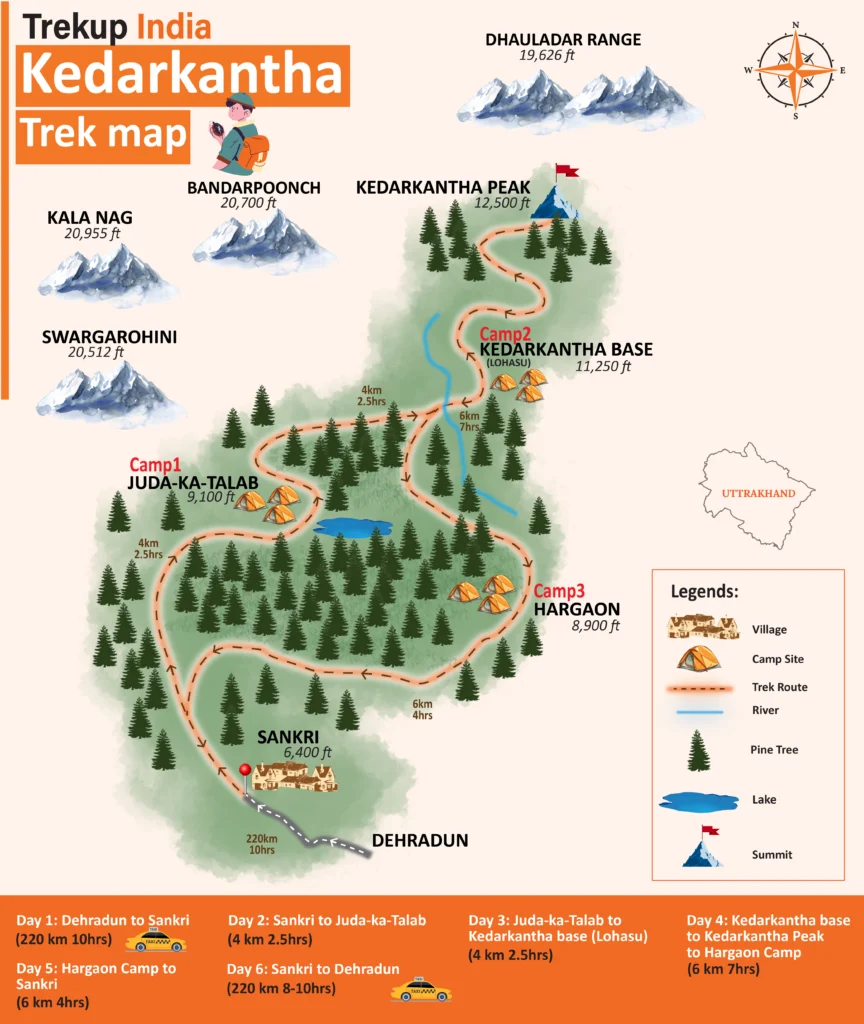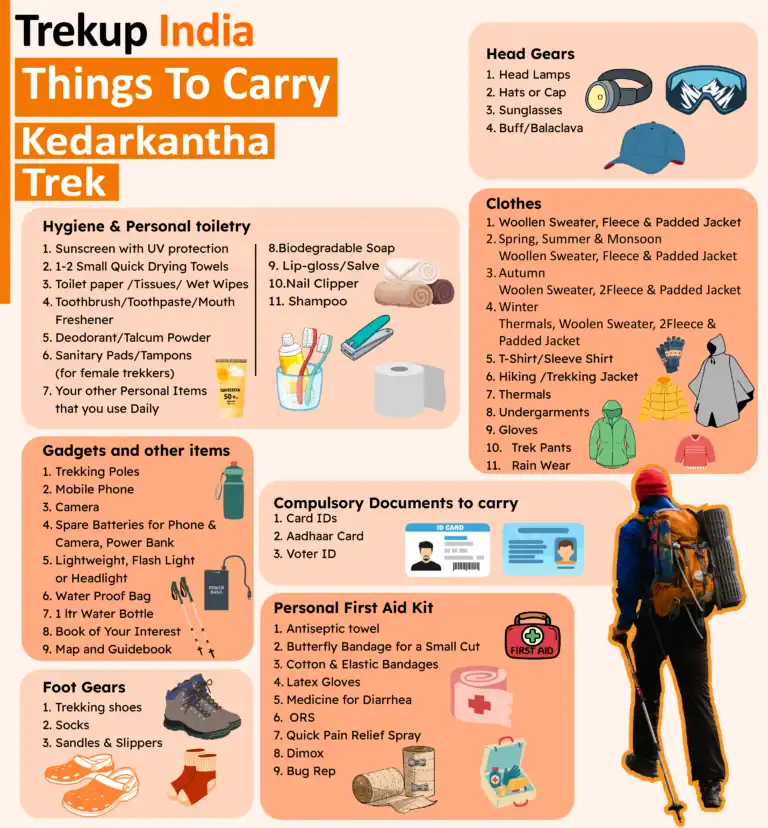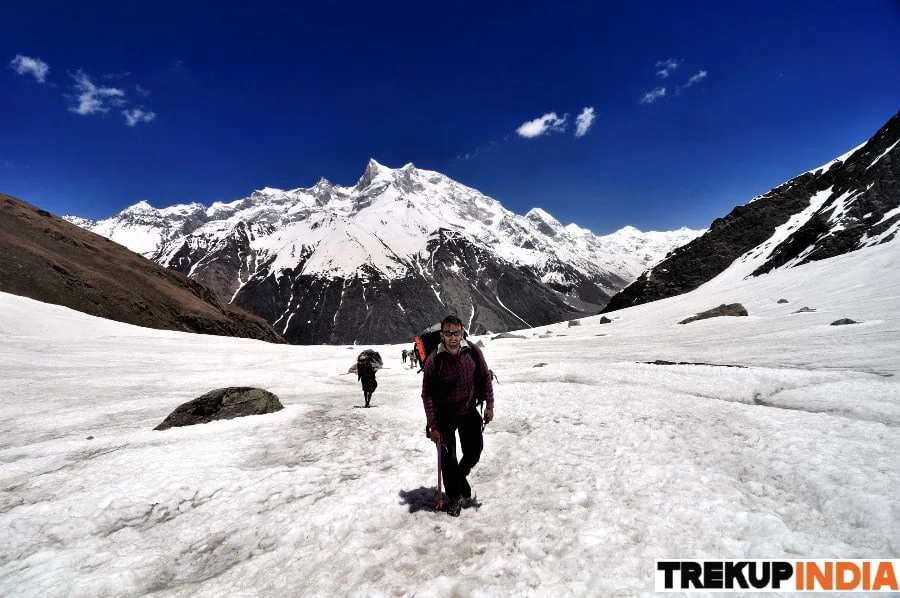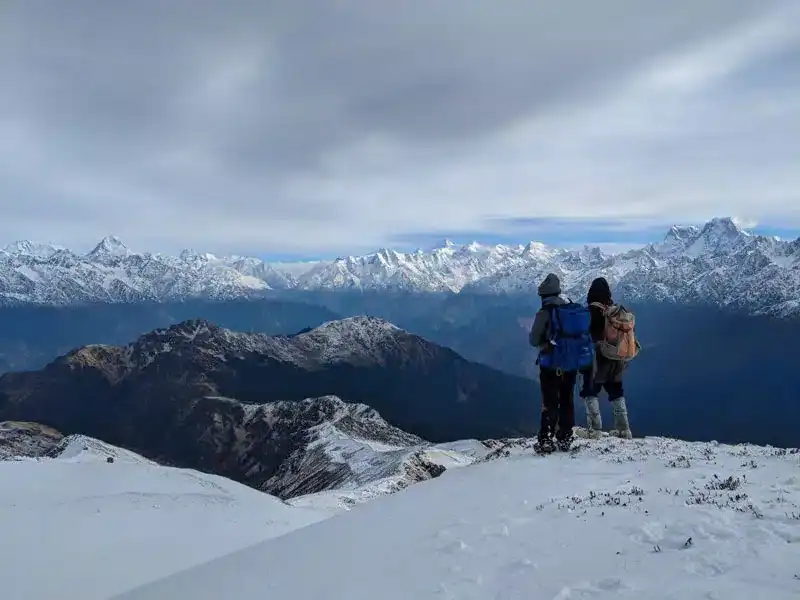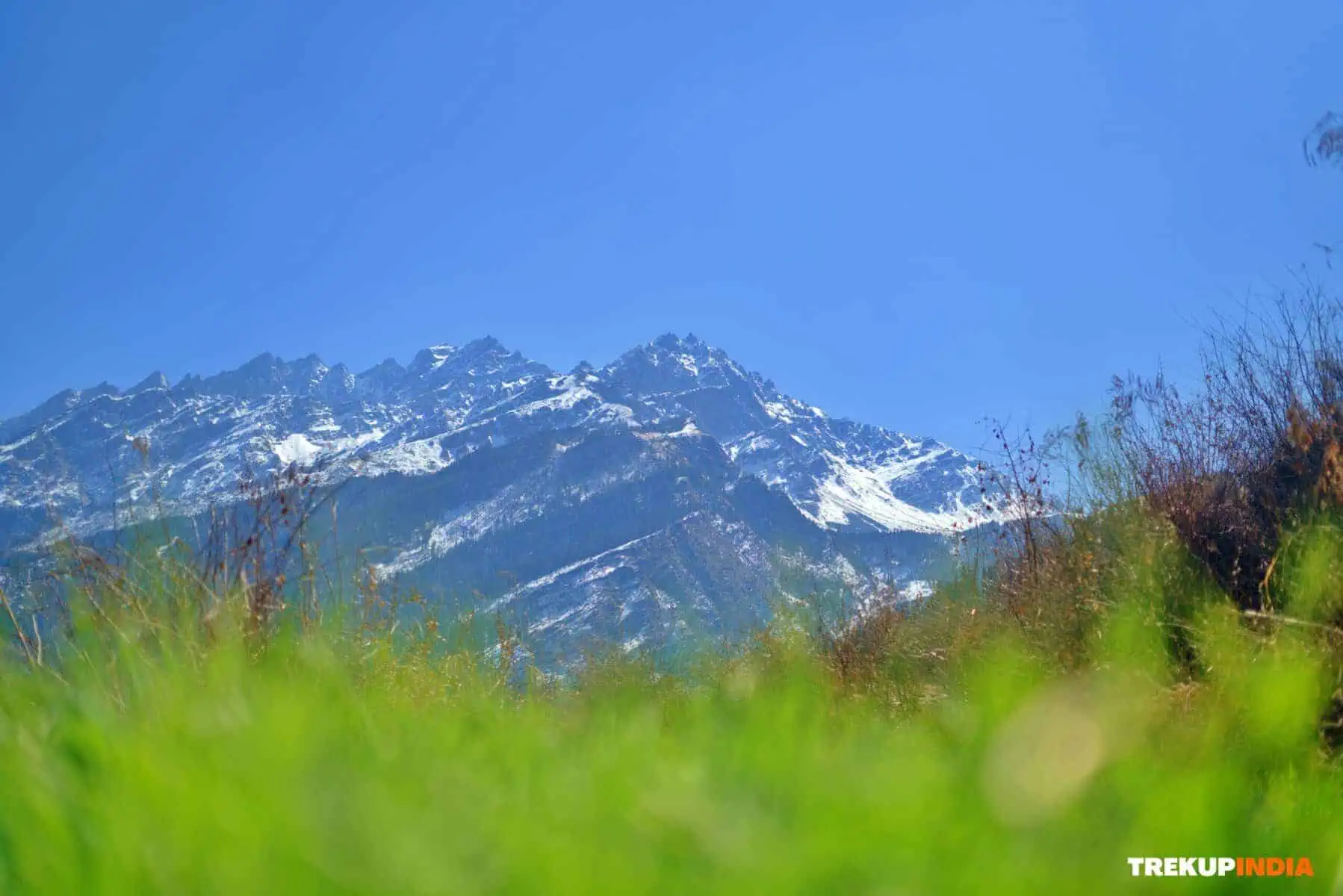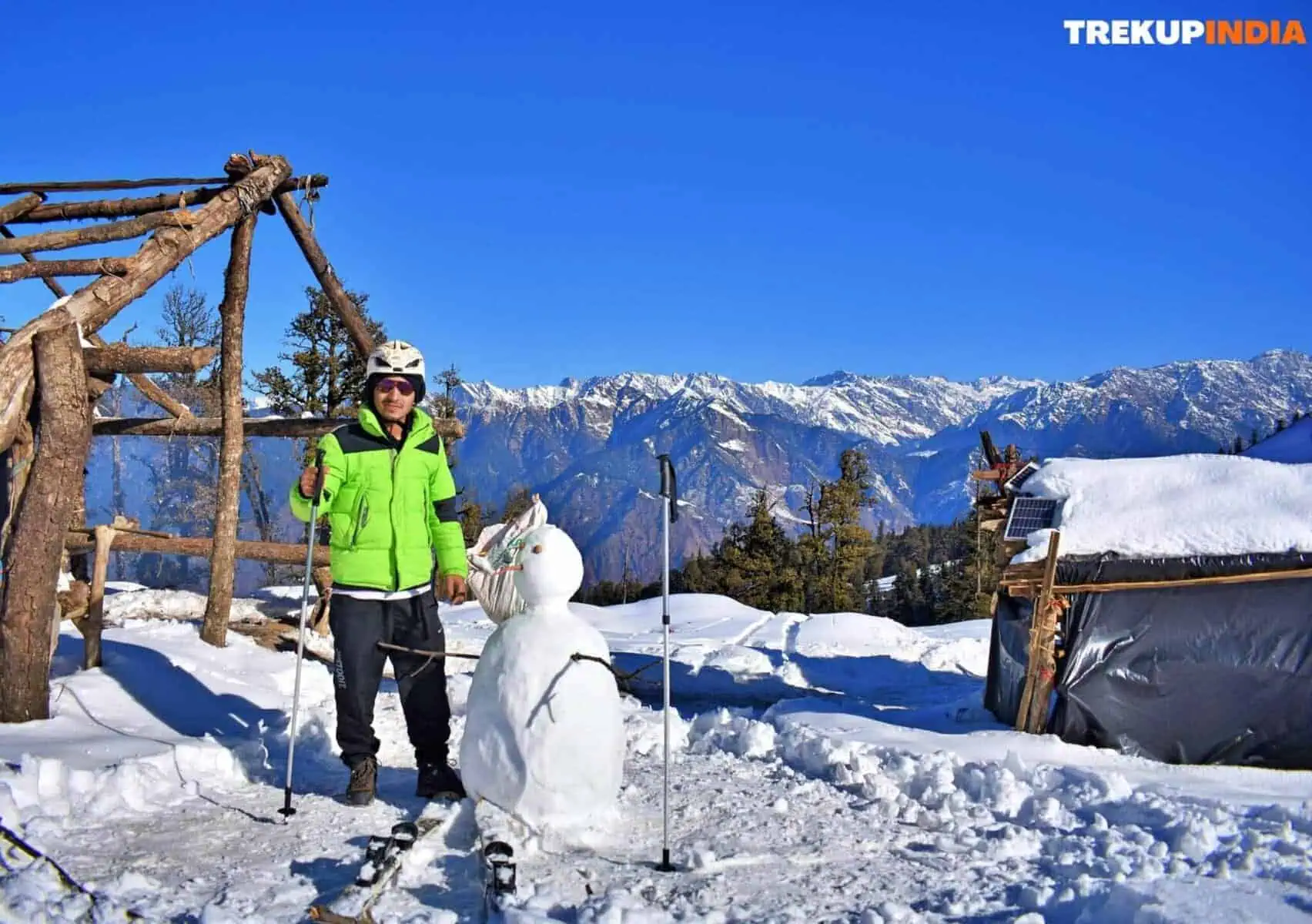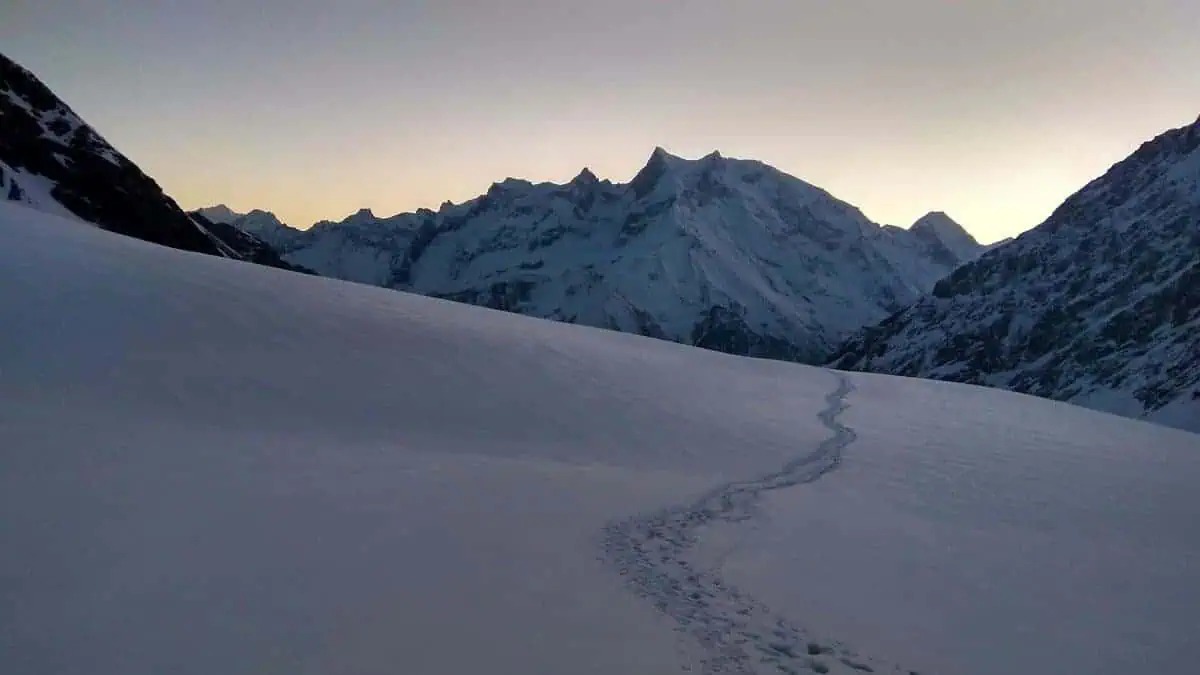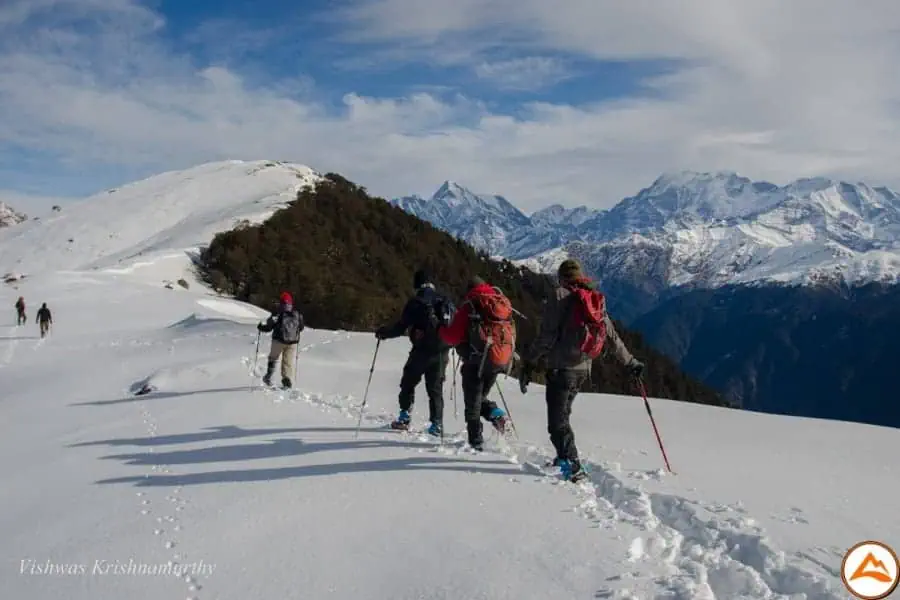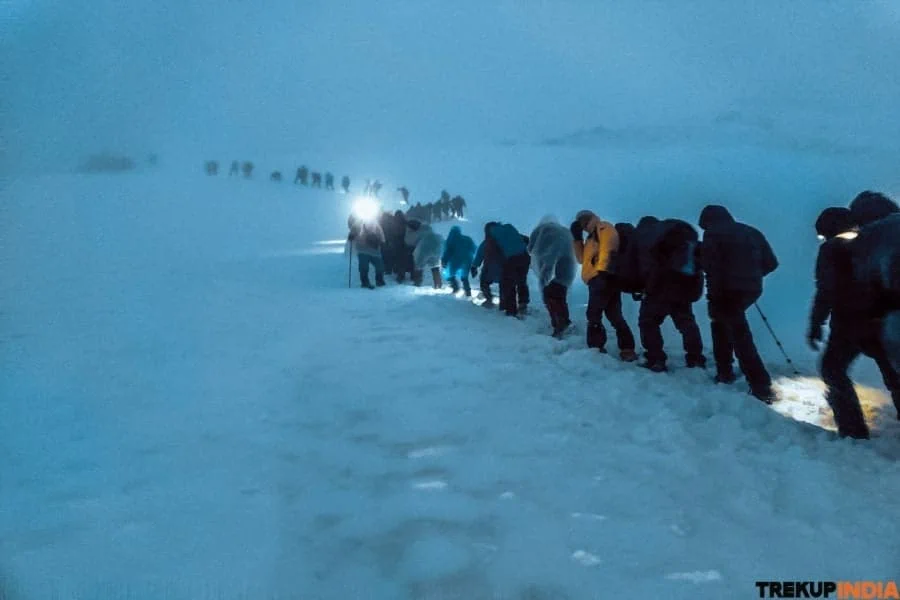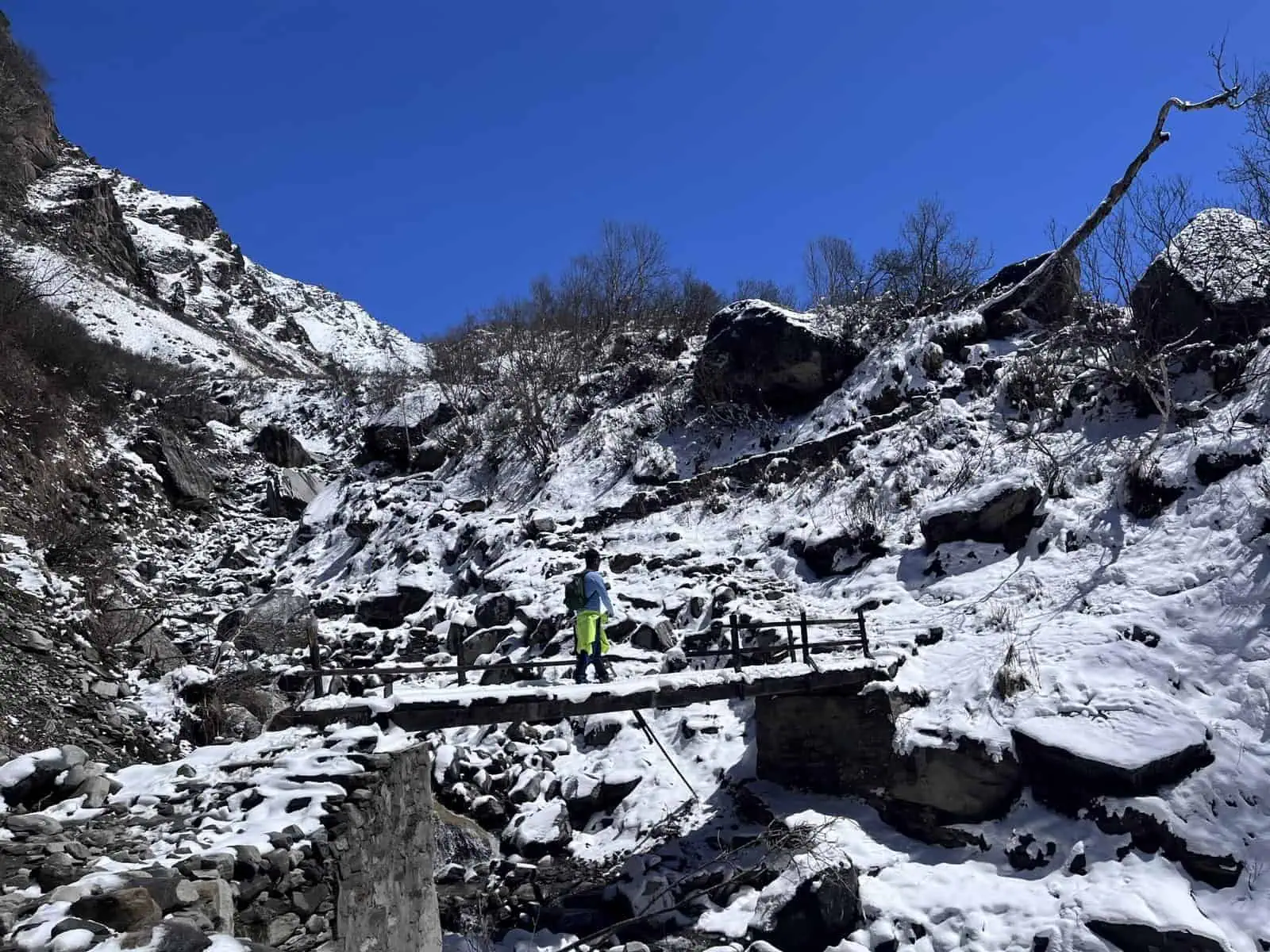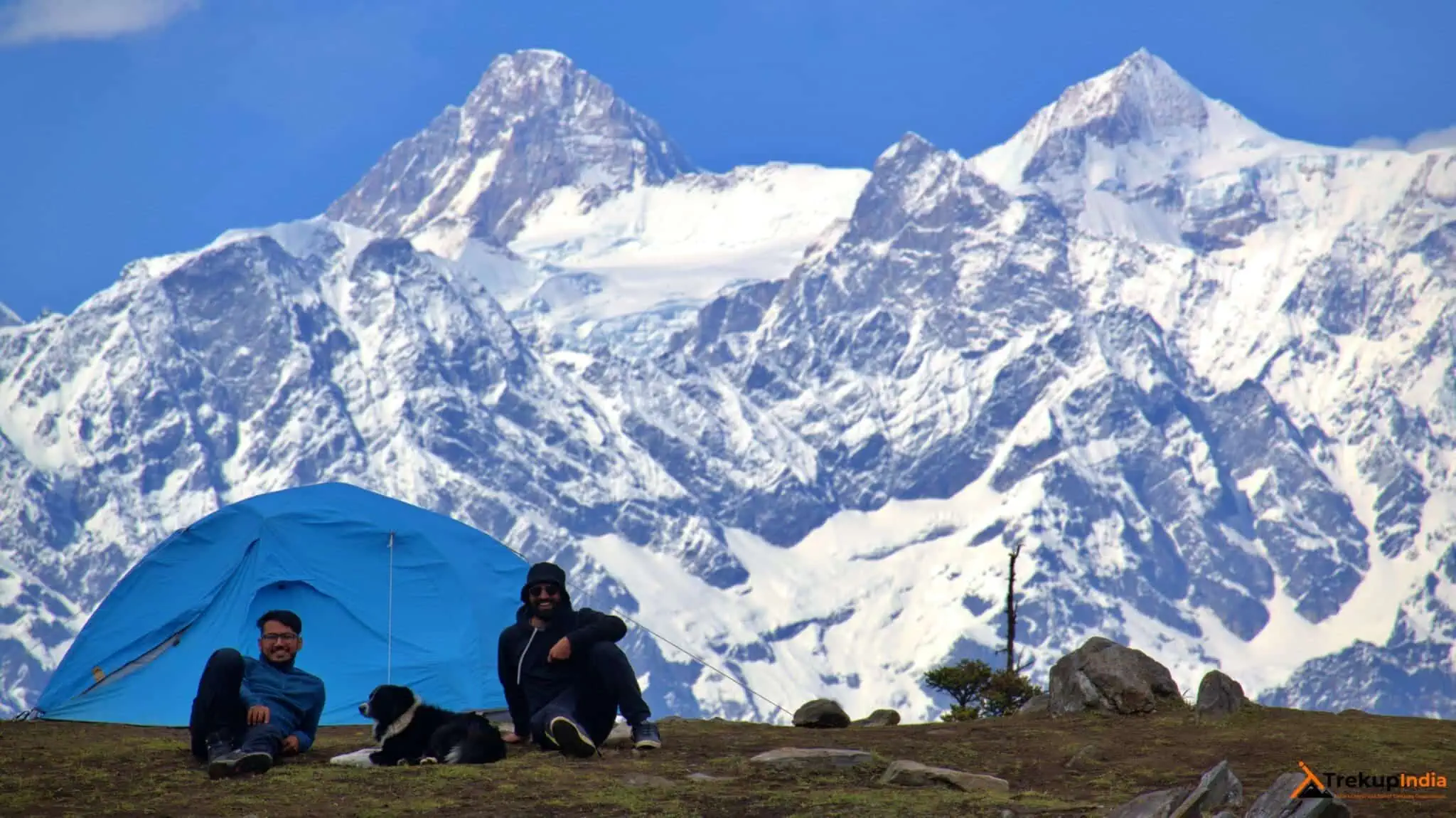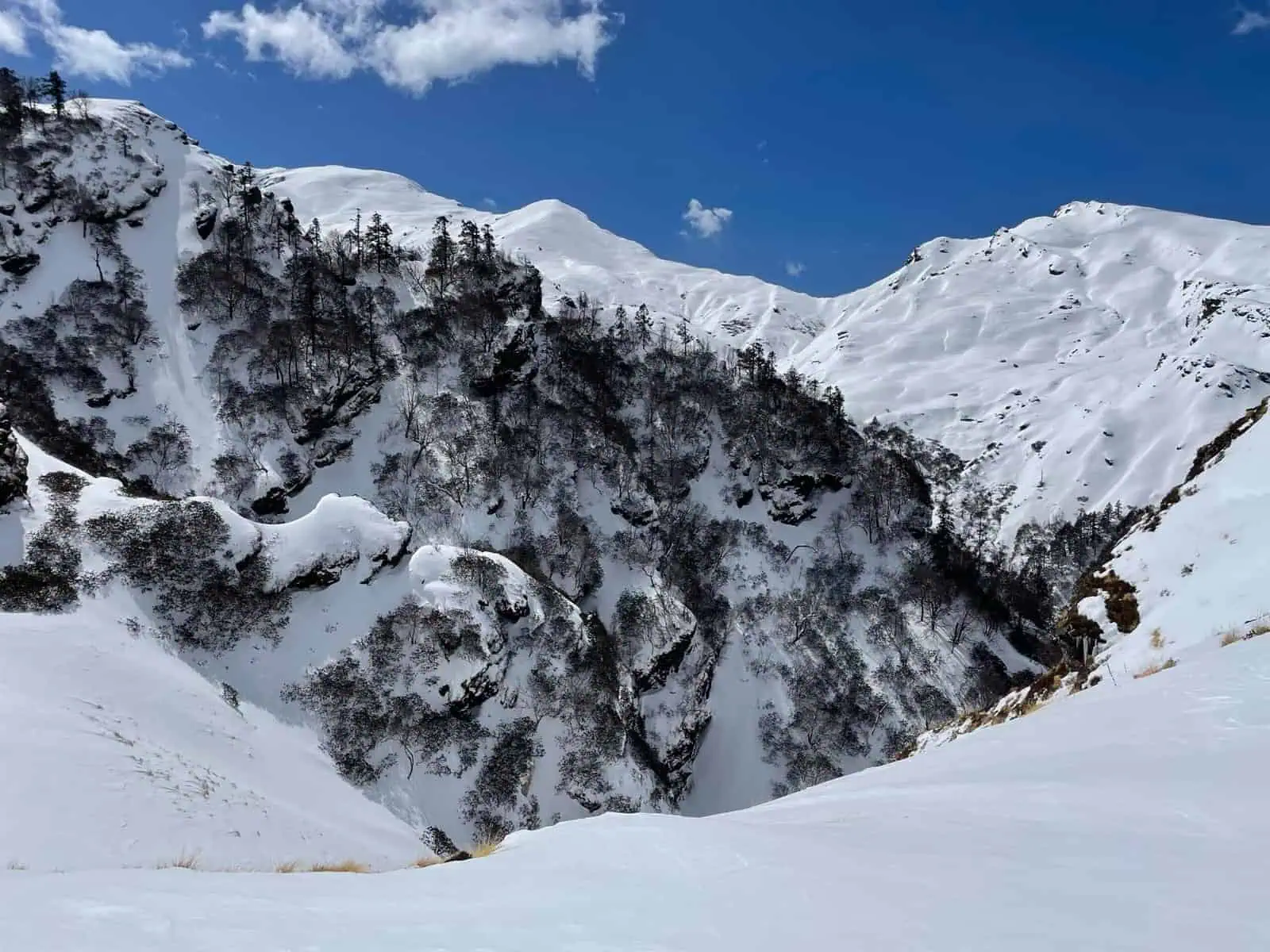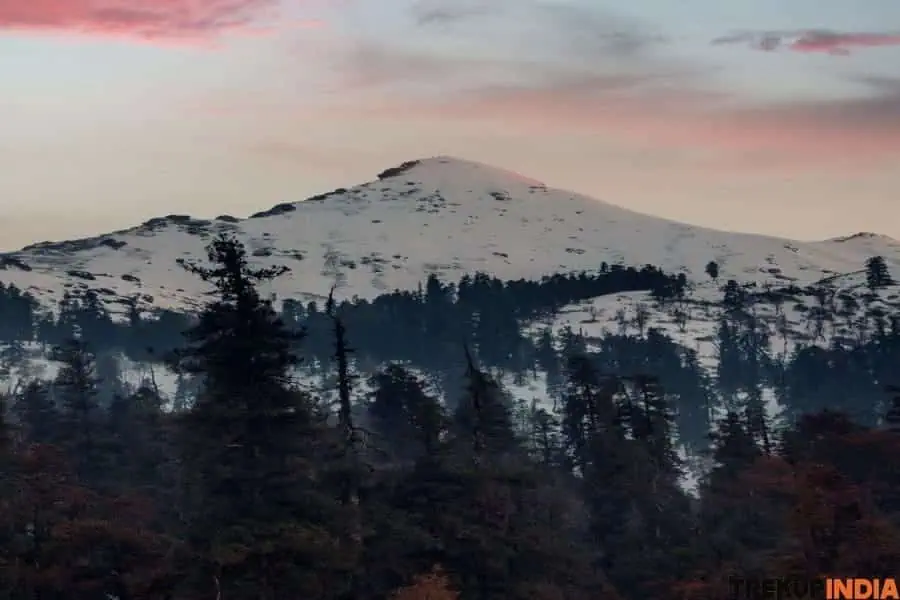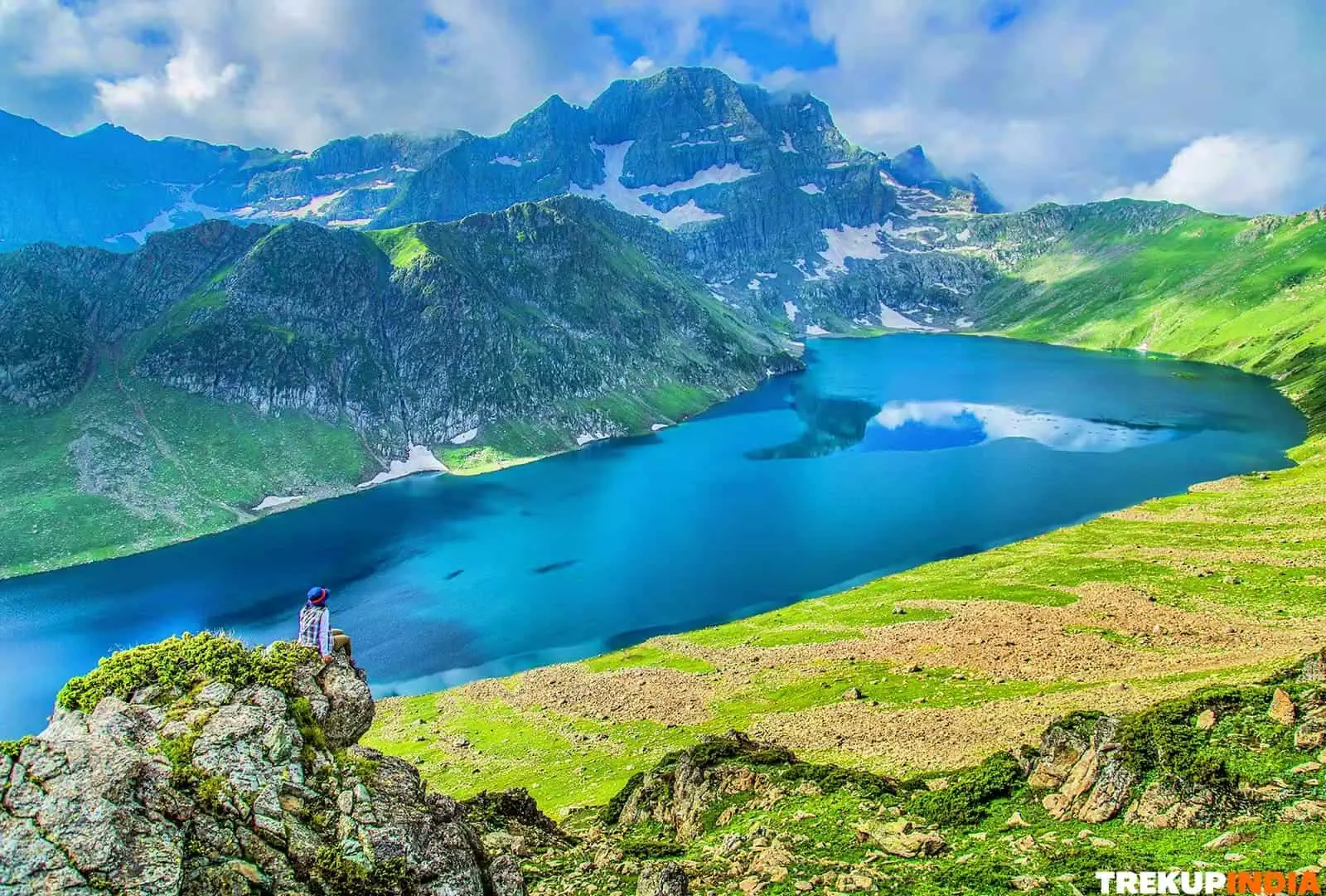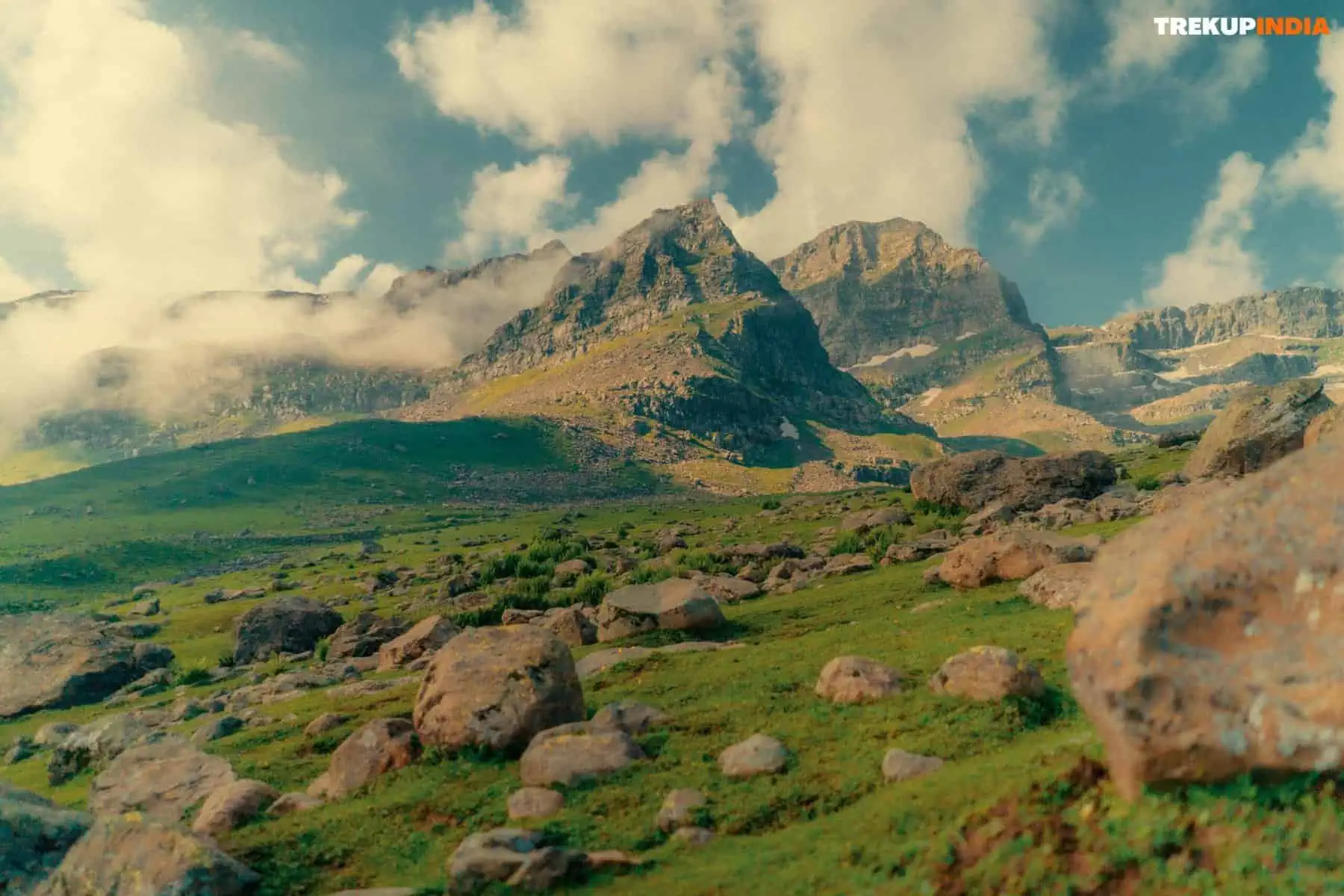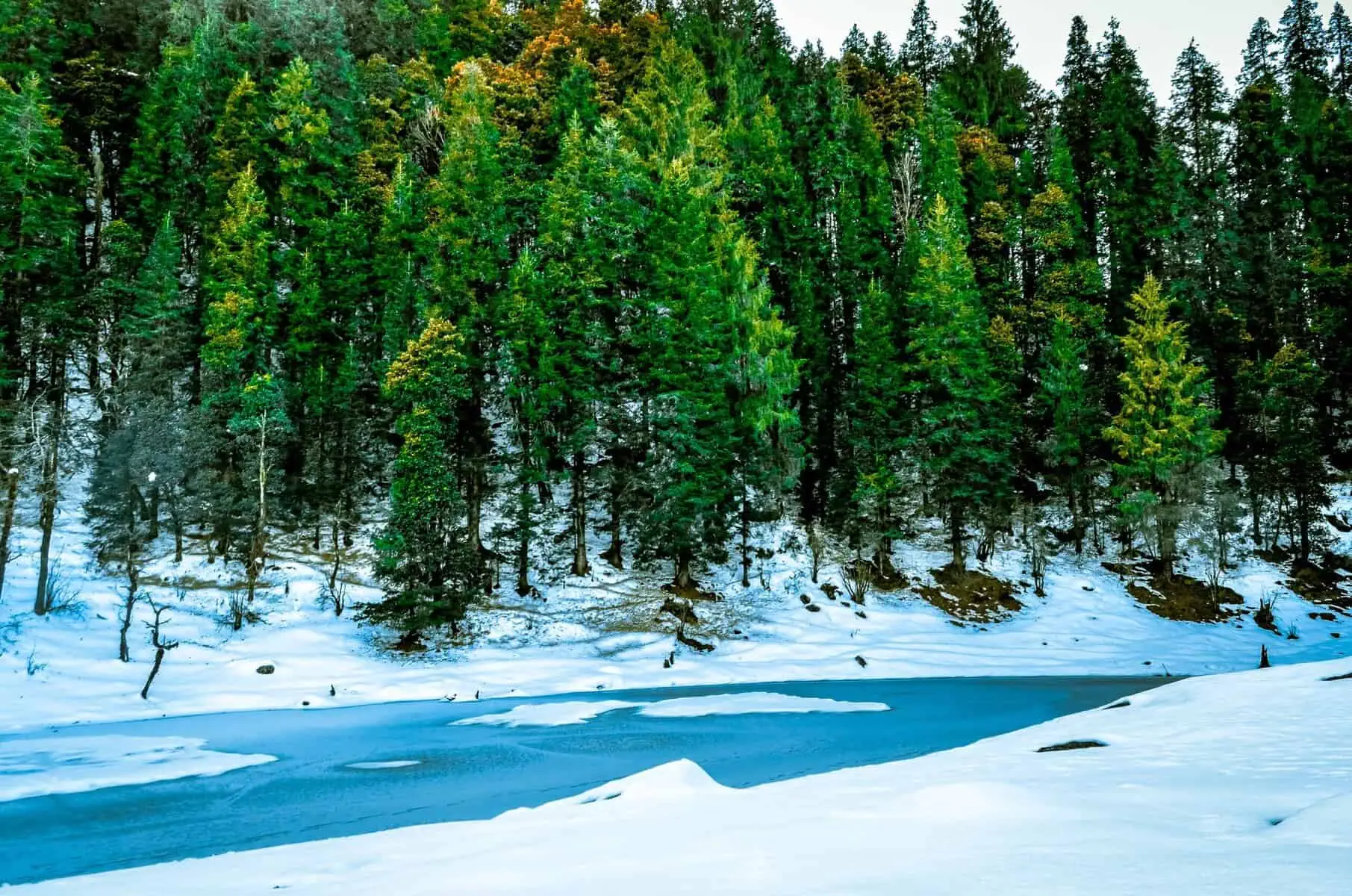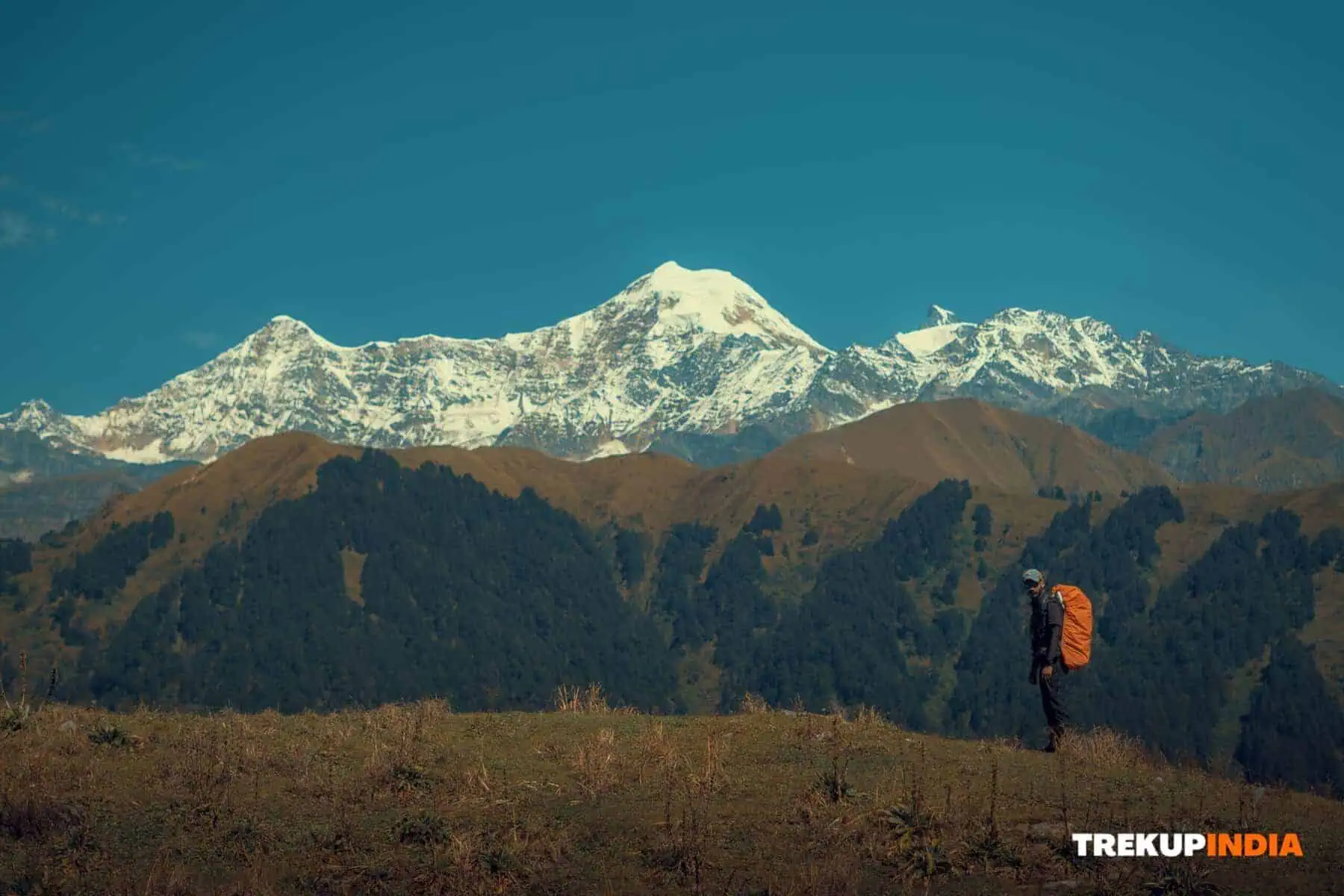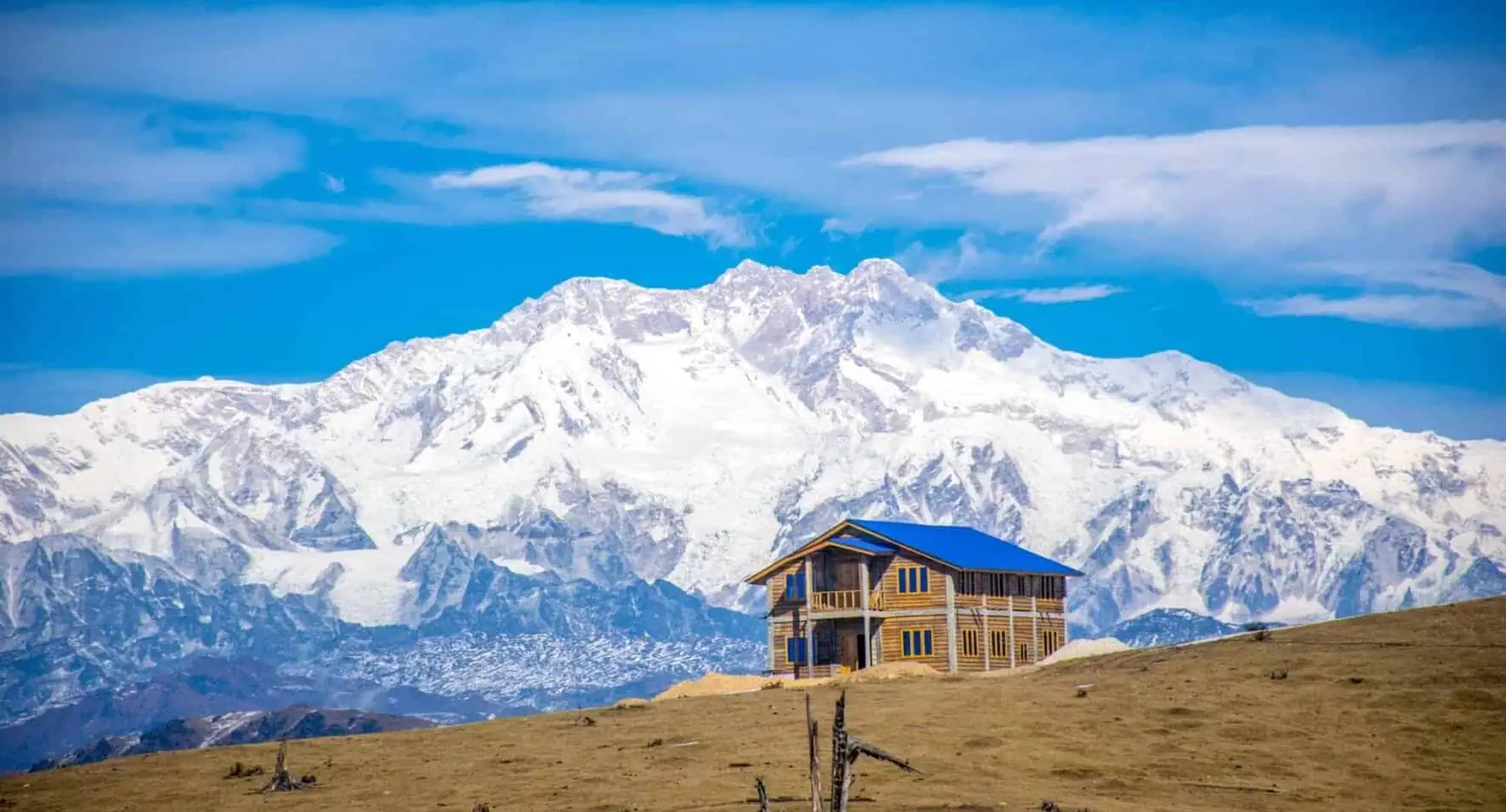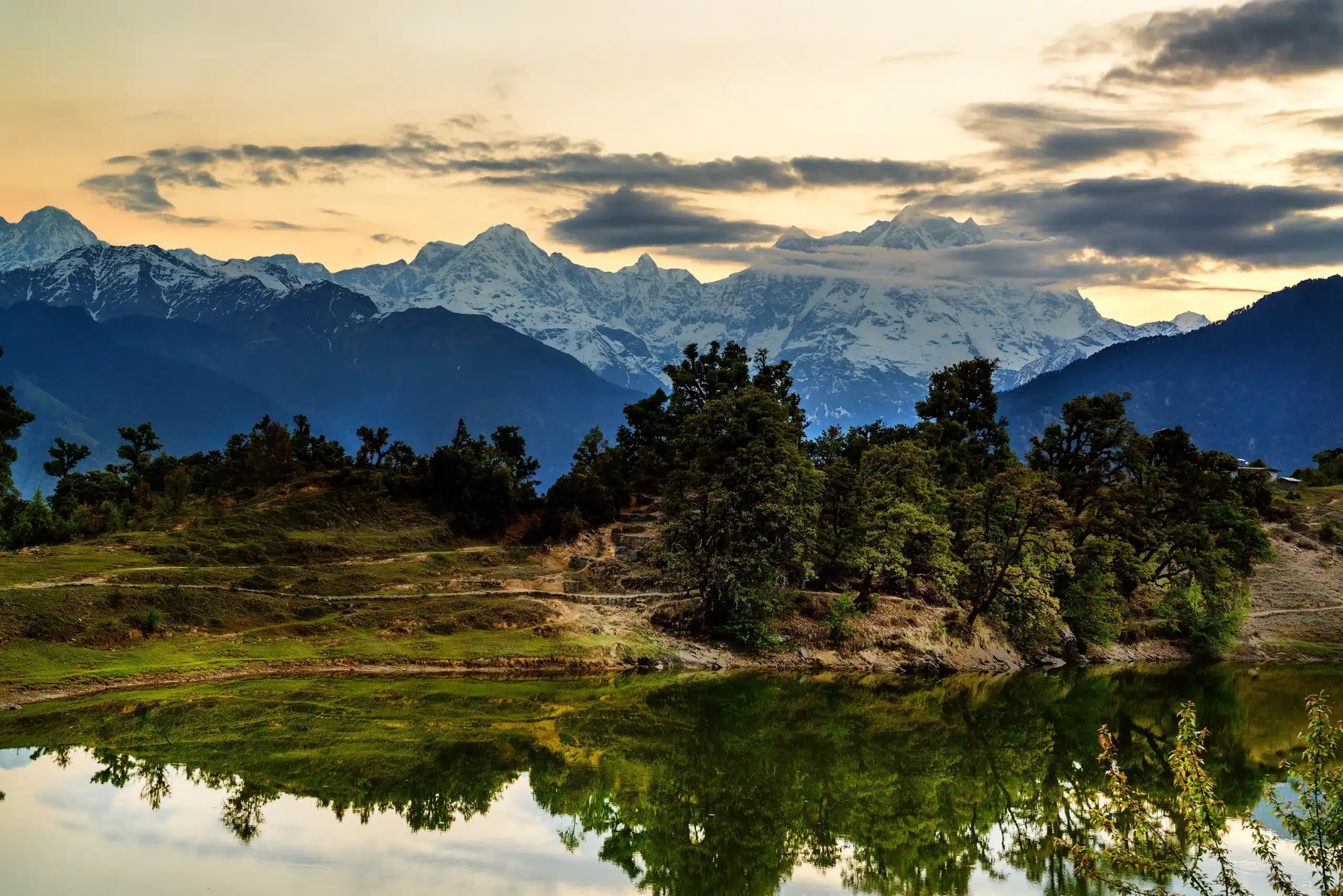Trek Grade
Easy - Moderate
Highest Altitude
12,500 ft
Base Camp
Sankari
Best Time
Oct, Nov, Dec, Jan, Feb, Mar, April
Trek Distance
23 Km
Kedarkantha Trek
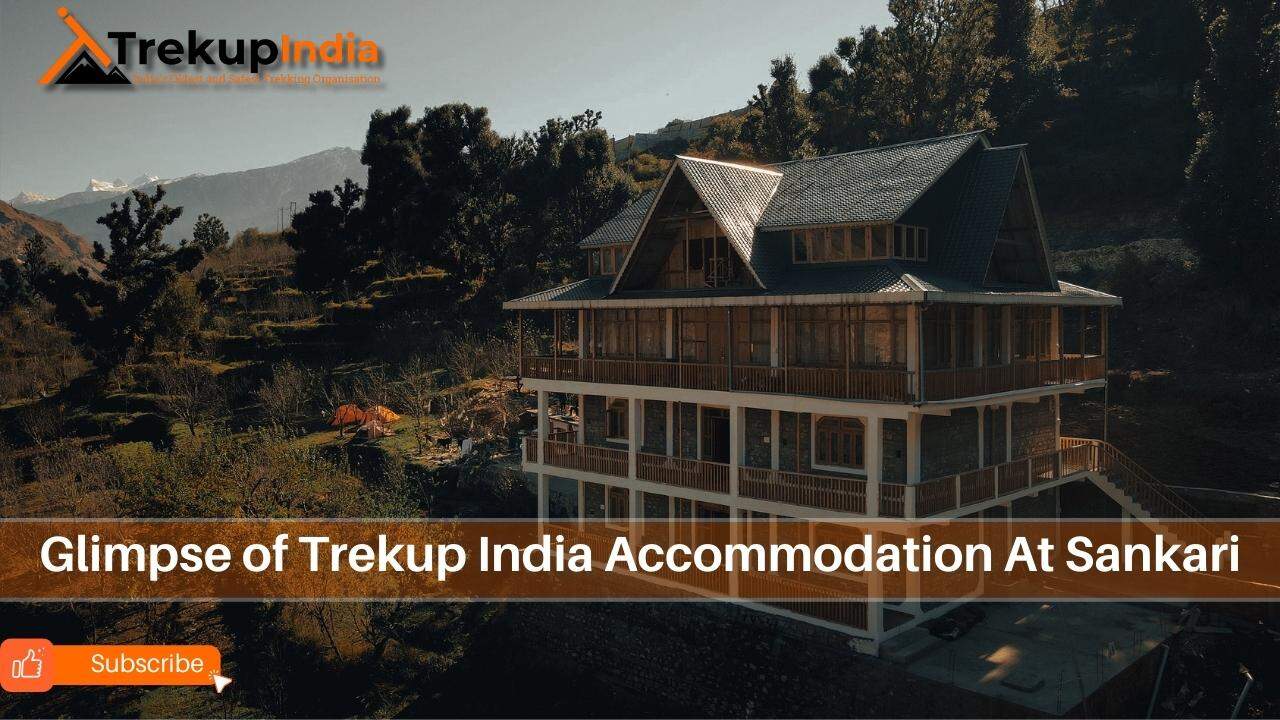
Get Ready to trek the most popular and adventurous Kedarkantha Trek located in Uttarkashi, Uttrakhand, India. Fringed with pine trees and decked with the prettiness of snow, Peak is often considered the best snow-trekking destination across the globe. Located at an altitude of 12,500 ft. above sea level, the trek to this mountain pass in Uttarakhand provides diverse levels of challenges to the voyagers. If you want to experience nature at its best and enjoy a wonderful trek then this Winter Snow Trek is definitely for you. During the trek, you will pass through mesmerizing picturesque views, rich forests, fields as well as snow trails. You need to know that Kedarkantha Summit is nestled in Govind wild life National santuary Park of Uttarkashi. This beautiful peak is encircled by several scenic river valleys, this valley is also known as upper valley of garwal, remotely situated villages the villagers of these villages are living here since Mahabharat Period. Kedarkantha is considered as top most winter snow trek in India, beginners can also do this trek in the Himalayas that you need to experience at least once in your life. Best time to do this trek is from the first week of November to the last week of April, you can find a lot of snowfall here. The campsites of this trek are beautifull all camps are covered with snow after mid november.
Although every trek in the Himalayas is special and known for its own beauty. Trekking often gives you a dose of nature which is not possible in the cities and also offers you the chance to stretch your psychological & physical limits. This Trek is one of those treks in the Himalayas that induce you to witness the beauty of nature that too in its pure form. Right from snow-capped mountains, green pastures forest, frozen lake to a pleasing divine summit, it offers everything that you wish for as a trekker. The summit ascent of trek is extremely rewarding and sure to give you amazing memories. All these views are seen from the starting point Sankri base camp till summit.
As you begin your trek in the early hours of the morning and gradually climb up the steep hill, you will experience breathtaking nature views. Kedar Kantha is popular mainly as a winter trek that starts right from a famous village called Sankri. This beautiful village is almost 210km away from Dehradun.
Generally, in the mountains, winter is quite harsh when it comes to weather. When the snowfall begins, the temperature drops down to minus that further blocks several roads, making most areas unreachable. All these things often make trek exciting and popular because here you can actually experience what winter feels like in the mountains. The temperature here drops to 10 degrees at night and even less but remember such kind of temperature is bearable only with a bit of carefulness. This is the reason why several tourists head towards the base village of this trek called Sankri, especially in the month of December, January, February, and March each year.
The drive from Dehradun to mussoorie and to sankari is one of the most stunning and charming drive in the Himalayas. So, don’t forget to carry your camera. On the way, you will come across the paths filled with snow as well as meadows that are going to offer you a mesmerizing glimpse of the Himalayan Peaks. The silent and peaceful streams along with tranquil lakes are sure to treat all your trekking tiredness and give you a tenderness in nature. You can do ski, if you are good at doing skiing then make sure you try it during the Winter. Skiing will give you the chance to experience an amazing view of the medows of himalyas covered with snow. Get ready to experience the pleasant view that will definitely soothe your eyes because while trekking you will come across rich forests that are wailed with recent snowfals n month of december. Not only this, but the gentleness and kindness of the Local people will surely impress you. This Trek is also considered as the place of Shiva, the ancient Hindu Lord, this trek is no less than a paradise. Silence, as well as the peacefulness of this trek, gives you an amazing feeling and even make you fell like you are in heaven. The paradise sky sight, and sky-knocking mountains, are sure to give you a feeling like you are standing on the edge of the earth. When it comes to this trek, there are several mythological stories behind it. It is believed by the locals of sankri that kedarnath temple initially was here, However, local people still believe that Kedarkantha is the only place of the Lord Shiva Live. Even if you are new to trekking, This Trek is the best trek of all time. Get ready to explore the stunning beauty of the view from Burane range to Bandarpoonch 1 and 2 and in between, you will also get the wonderful sights of Rupin range, Har Ki Dun, Swaragrohini 1 to 4 as well as Black Peak, during your trek. Height and altitude of Kedarkantha Trek is 12,500 ft and is an achievable altitude for all beginners and first-time trekkers. If you are fond of trekking and want to experience nature at its best then do plan for this trek once.
Trek Cost
- Stay will be on a twin-sharing basis in tents For 6 Days & 5 Nights Package Only
- + 210 Trek Insurance (Optional)
- Discount Policy
- Transport Optional ( INR - 1,500 extra )
Pickup time 6.30 A.M from Prince Chowk, Near Dehradun Railway Station
Choose Packages
Kedarkantha Trek Videos
Videos by experts watch these videos to prepare well for a Successful Trek
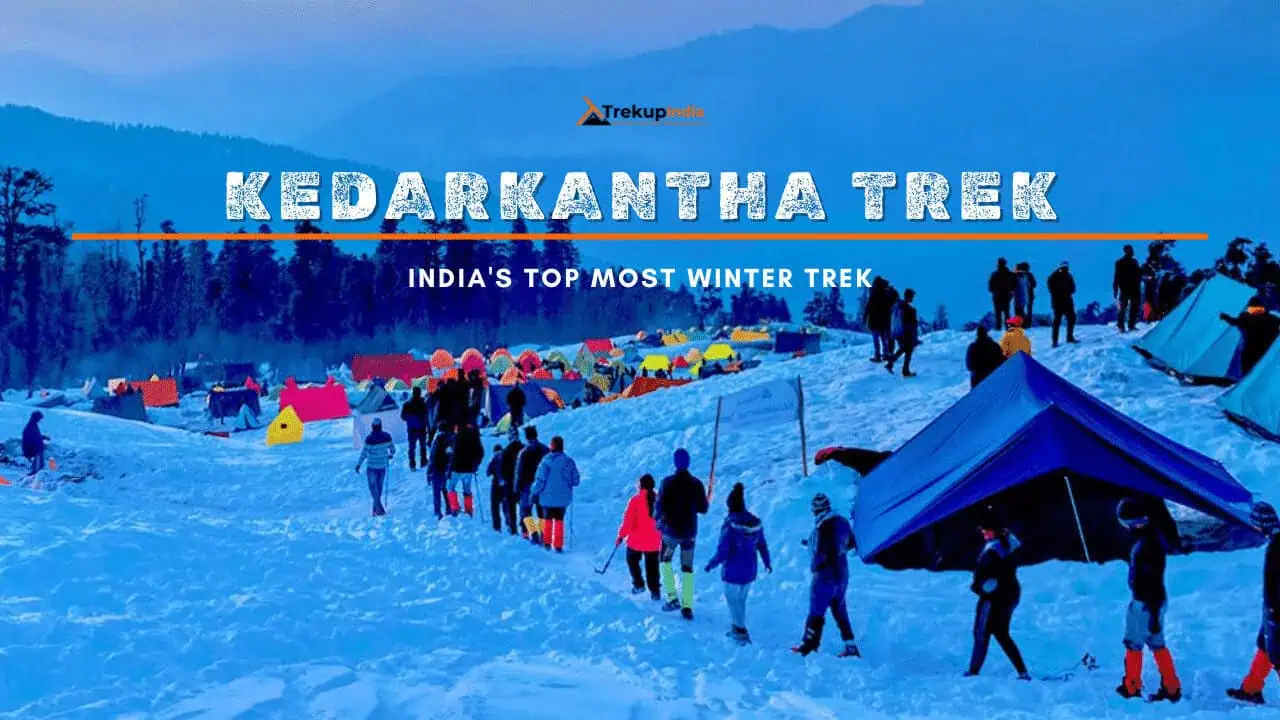
Want To Trek Like Pro?
Check out the following videos if you want to trek like a pro trekker and improve your skills. These videos contain helpful tips, tricks, and techniques to help you trek like a pro. Whether you’re a beginner or an experienced trekker, these videos can provide valuable insights to enhance your trekking experience. So, watch the videos below by Trekup India experts to take your trekking skills to the next level.




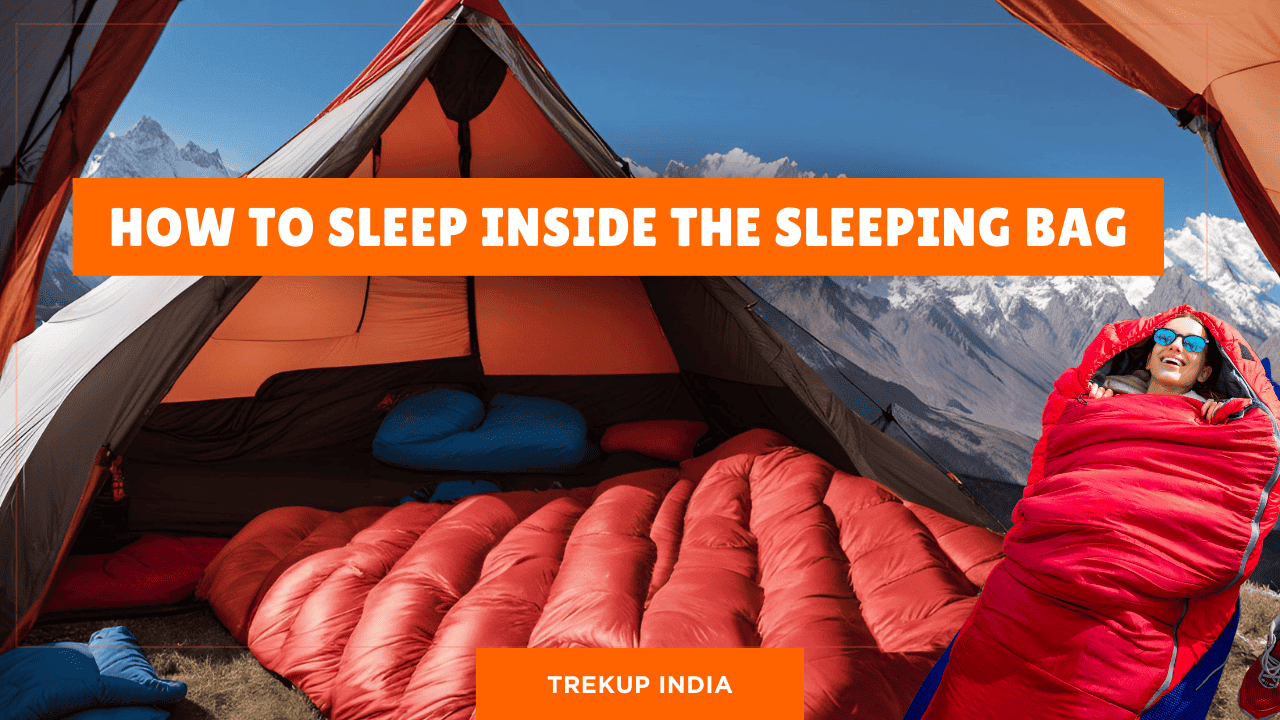


Know Everything About Acute Mountain Sickness
Acute Mountain Sickness is a medical condition that can occur when individuals travel to high altitudes, typically above 8,000 feet. It is caused by the decrease in air pressure and oxygen levels in the air as altitude increases. Symptoms of Acute Mountain Sickness may include headache, nausea, vomiting, dizziness, and difficulty sleeping. To avoid Acute Mountain Sickness, it is important to gradually adjust to high altitudes and seek medical attention if symptoms worsen. To learn more about this condition, check out the videos by Trekup India.

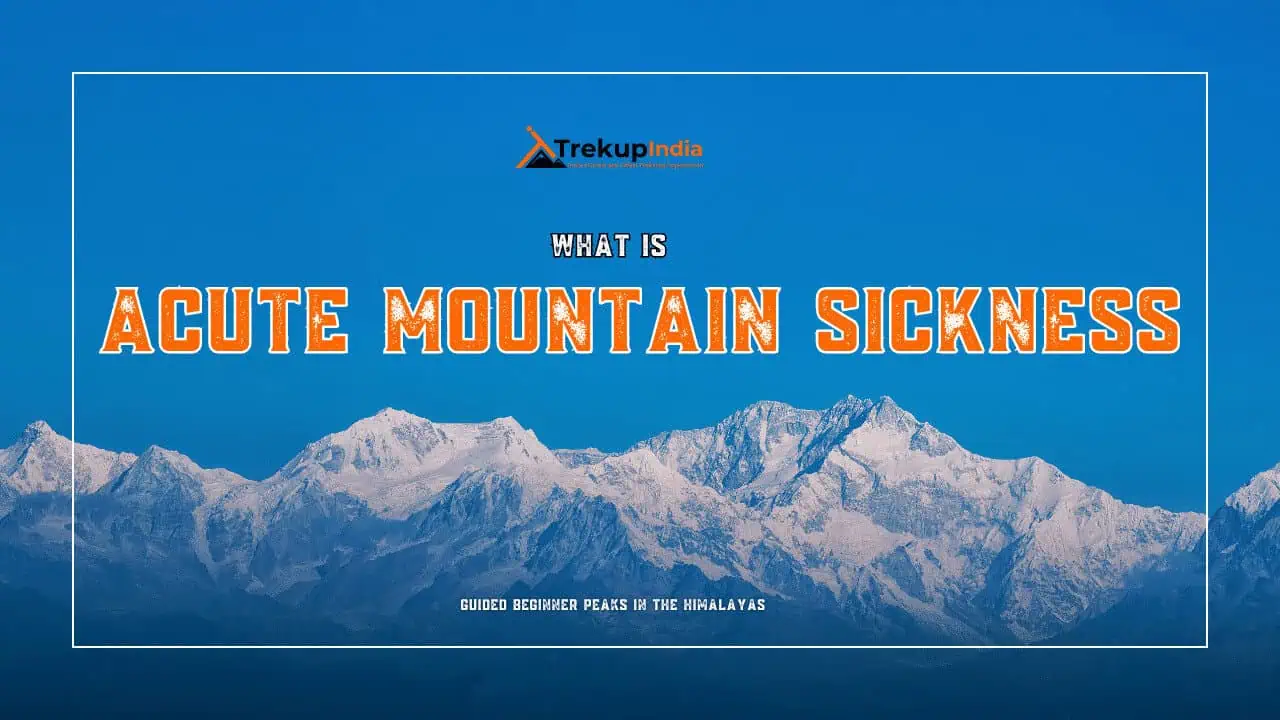
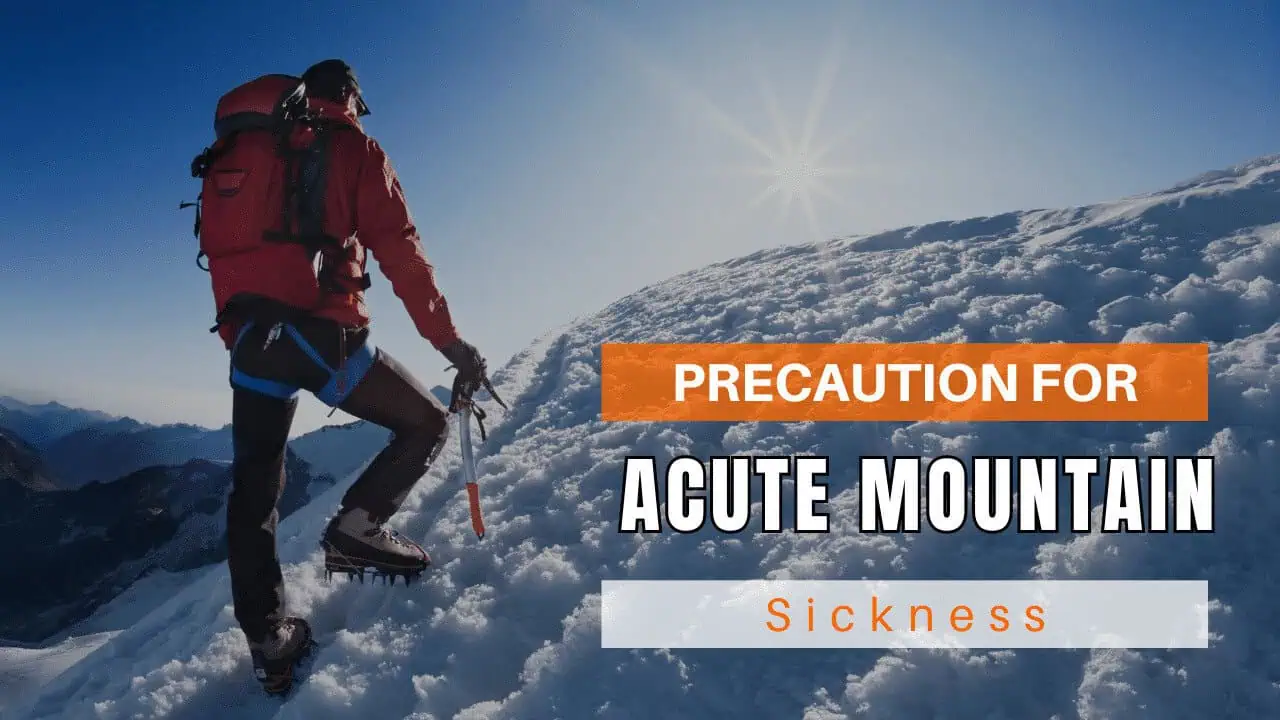
Day Wise Detailed Itinerary of Kedarkantha Trek
Day 1: Pickup From Dehradun and Drive to Sankri
- Drive Distance: 220 Kms
- Drive Duration: 10 Hrs.
- Sankri is located at an altitude of 1920 meters or 6,400 feet.
- Dehradun to Sankri 220km drive which will take almost 10 hours.
- All the trekkers will be pickuped from Hotel garand which is near Dehradun Railway station at 6:30 AM in a Bolero (6-7 seaters), Innova (7 seaters), Tempotravellers (12 seaters) & Bus.
- You will be reaching at Sankri till 05 in the evening.
- Jio & BSNL network available.
- Night stay in guest house and hotel.
Your trip will start from Dehradun for the Kedarkantha Winter Snow Trek. All the trekkers need to arrive at Dehradun before 6 am because till 06:30 am, we will start our drive to Sankri.
You need to know that the distance between Dehradun to Sankri is almost 220km which will take approximately 10 hours to reach. Sankri is located on the National Highway 123 and is a beautiful drive. While driving from Dehradun to Sankri, you will be spell-bounded with the beauty of valleys as well as forests.
Before reaching Sankri about 22km, all the trekkers will get an amazing feeling of serene Himalayas as well as greenery. You will also come across Govind National Park which is well-known for its huge collection of Flora. In this park, you will find the Flora which is available only in this region and nowhere else in the country.
Day 2: Trek from Sankri to Juda-ka-Talab
- Altitude Gain: 6,400 ft.
- Trek Distance: 4 Kms
- Trek Duration: 2.5 Hrs
- On this day we will to 9100 ft from 6400 ft.
- Trekking for 4km will take 2.5 long hours.
- The path will pass through maple trees, oak forests, water streams, and stunning meadows.
- Night stay in tents (twin sharing).
On day 2, you will begin the trek towards Juda Ka Talab which is located at an altitude of 9,100 feet. Till afternoon, you will cover almost 5km which takes 5 hours but this can also vary on the capability of the trekker.
Get ready to experience the diverse adventures on the trail. While walking, ice and slush might bother you a little but the guides of TrekupIndia will help you out so don’t worry.
The trek will start with a beautiful pine & maple forest that will further rise alongside the wildlife as well as pastures. As you trail upwards, you will spot some beautiful huts alongside the fields.
While trekking, you will see a goliath lake on the left and thick pine & oak backwoods on the other side which is a perfect example of beauty. You will get the Luke warm water all around the lake and the rest water will be colder.
In winters, you can see a sheet of ice instead of water, giving you an eye-catchy view. This lake also has a big natural tunnel that offers water to the villagers.
Primarily, you will be climbing through the bridges and one of the exciting things about this trek is that you will find Himalayan Languor. You need to know that they are shy animals and hardly anyone gets the chance to see them.
You might also witness boars, hares as well as martens in this region. Juda Ka Tal is a beautiful destination in the thick pine and oak forest. At night, you will be served with hot & healthy dinner. Your night stay will be scheduled in a camp where you can enjoy the beauty of Mother Nature’s lap.
Day 3: Trekking from Juda-ka-Talab to Kedarkantha Base (Lohasu)
- Altitude Gain: 9,100 ft
- Trek Distance: 4 Kms
- Trek Duration: 2.5 Hrs
- On this day, we will trek to 11250 ft from a height of 9100 ft.
- Trekking for 4kms which will take time of 2.5 hours.
- Most of the trail is on a ride and under the beautiful oak trees
- You will be passing through some pastures where shepherd log huts can be seen.
- Night stay in tents (twin sharing), giving amazing views of nature.
Get up early in the morning and witness the breathtaking sunrise that will definitely leave you stunned. On day 3, we will begin the trek for Kedarkantha base which is located at a height of 11,250 feet.
Kedarkantha Trek Base i.e Lohasu from Jadu Ka Talab is almost 4kms and it takes 2.5 hours to cover at a moderate speed. You need to know that Jadu Ka Talab is a wonderful lake that is surrounded by pine trees that often gets freeze at the time of winters and also turns out to be a spot for adventures as well as fun activities for the trekkers.
Gradually, the trail will get steeper as you keep on moving upwards. Your trek guide will teach you different skills for snow slopes, so be attentive and listen to him carefully. He might also guide you about how big your footsteps should be.
Your trekking will again start from the dense forest of pine and oak trees. The trail also passes through the steep ridges. As you gradually walk towards the path and reach a height of 10,400 feet, you will witness the snow traces that will definitely give you magnificent views of nature.
Get ready because the spectacular views are still waiting to shock the trekkers because before reaching the base camp all the trekkers can observe the stunning views of different arc-shaped ranges that are covered with snow like Bandarpoonch, Swargarohini, Kala Nag as well as Ranglana that are standing with great pride in the lap of Mother Nature.
At night, you will be served with delicious dinner in your tents only.
Day 4: Early Morning Hike From Kedarkantha Base to Kedarkantha Peak; Descend to Hargaon camp
- Altitude: 12,500 ft
- Trek Distance: 6 Kms
- Trek Duration: 7 Hrs
- We will wake up Early morning for the summit push/peak.
- Trekking for almost 7 hours for a 6 km trek
- You will see the sun rise if we arrive on time to summit
- Served with lip-smacking lunch at the camp base only
- After lunch, descending towards Hargaon
- For snacks time we will reach Our next Campsite Hargaun
- Night stay will be organized in tents (twin sharing).
Day 4 is going to be a long one because you will be heading towards the Kedar Kantha peak. Today, you will be trekking from 11,250 feet to 12,500 feet and trek for almost 6kms which will be covered in 7 hours. It is necessary for you to know that the trail will be steeper, so be prepared accordingly.
At the time of trekking, you will see the magical colors of nature as well as the majestic sights of different ranges including Rupin. The reason for calling it Kedar Kantha, rumors from villagers is; 1st they tried to build Kedarnath temple in that peak but they heard some animal’s sound which means omen for a divine event.
Till then they constructed Lord Shiva’s statue till neck ad in Hindi neck is called Kanth as well as Lord Shiva has a lot of names and Kedar is one of them. This is the reason, why it is known as Kedarkantha.
In Kedar Kantha peak, you can treat your eyes with appealing views of Bandarpooch, Swargarohini, Kalanaag, Gangotri as well as Yamunotri. After reaching the summit, the captivating views of nature will definitely balance your emotion and leave you stunned.
On the top, you will also find a small temple which is dedicated to Lord Shiva and Goddess Parvati along with a small shrine of Lord Ganesh too. Apart from this, we will also start descending to Hargaon camp on the same day.
A night stay will be scheduled at the campsites, giving you beautiful views of valleys and nature.
Day 5: Trek from Hargaon Camp to Sankri
- Altitude Loss: 2,500 ft
- Trek Distance: 6 Kms
- Trek Duration: 4 Hrs
- Returning back from Hargaon camp (8,900 feet) to Sankri (6,400 feet)
- Trekking for 6kms which will take almost 4 hours
- Descend 2,500 feet through dense pine woodlands
Day 5 is marked for descending further to Sankri from Hargaon Camp. We will be descending from 8900 feet to 6400 feet. The time for descending the 6kms long trail will take almost 4 hours and even more if you follow a moderate speed.
The day has arrived when you need to leave the regal views of the Himalayas as well as snowcapped mountain ranges because we will be heading back to Sankri. It is important for you to know that the trek is going to simple as the distance is short.
Sankri is the stoppage village for several treks like Bali pass, Borasu pass, and many more. The morning at Hragaon camp is going to welcome you with a stunning sunrise right between the pine trees.
After having breakfast, you will pack your back and start descending through a clearly marked paved pathway and reach Sankri.
Day 6: After Having last tea, coffee with us, Departure from Sankri to Dehradun
- Drive Distance: 220 Kms
- Drive Duration: 8-10 Hrs Approx.
- Back to Dehradun, which is 220km from Sankri.
- The drive will take almost 8 to 10 hours, but on the way, you will come across beautiful scenes.
- By Tata Sumo or any other vehicle, you will be dropped at Dehradun Railway Station.
On day 6, you will be heading towards Dehradun from Sankri which will take almost 10 hours as you need to cover 220km. You will be leaving Sankri early in the morning so that by evening you reach Dehradun.
By 7 – 8 pm in the evening, you will be reaching Dehradun, so get your bookings done for your hometown accordingly.
Make sure to collect all your memories while driving back to Dehradun.
We’ve prepared a comprehensive Trek Route Map for your upcoming adventure to Kedarkantha Trek, which outlines the entire journey including all stops and trails. This map provides detailed information on the terrain, distance between points of interest, and estimated travel time to help ensure a safe and enjoyable trek. We’ve carefully curated the map to ensure that you have all the necessary information at your fingertips. Please take a moment to review it thoroughly, and don’t hesitate to reach out if you have any questions or concerns.
The Trek Altitude Chart is a useful tool for Trekkers to monitor their altitude changes during their rides, allowing them to plan their routes more efficiently and track their progress over time. This Kedarkantha Trek chart is beneficial for both casual and experienced Trekkers, helping them make the most out of their Trek experience.

Trek Cost Inclusions
- Stay:
- 3 Nights of tented accommodation at individual campsites of Trekup India on twin sharing and 2 nights at sankari in Trekup India Luxury Hotel on multi sharing basis. ( For 6 days & 5 nights Package)
- 3 Nights of tented accommodation at individual campsites of Trekup India on Triple sharing and 1 nights at sankari in Trekup India Luxury Hotel on multi sharing basis. ( For 5 days & 4 nights Package)
- Meals: Trekup India will provide freshly cooked meals during the trek starting with Dinner on Day 1 to tea, coffee on day 6 (Meals are simple, nutritious, and vegetarian)
- Transport (Optional): Dehradun to Sankari and return. ( 1500 extra )
- Trek Insurance (Optional): Trekup India recommends that all trekkers consider getting trek insurance. This is optional, but highly recommended. Trek insurance covers unexpected events that may occur during your trek. The cost of the insurance starts from INR 210 (extra). Please read more about what is included in the coverage and why it is mandatory on treks.
- Trek Equipment: Sleeping bag, Sleeping tents, Kitchen tent, Dining tent, Toilet Tent.
- Amenities: All utensils, sleeping mattresses (Black foam mats), Crampons, and Gaiters for snow.
- Health & Safety: First Aid Box, Oxygen Cylinders, Stretchers, Oxi meters, BP Machines, health.
- Permits: Forest Permits and Camping Permission Fee
- Trek Crew: High Altitude Chef, Helpers, Trek Leader & Guides, and other support teams.
- Potters & Mules: Potters and Mules are to carry all trekking equipment, ration, and vegetables.
Trek Cost Exclusions
- GST 5% (it is Mandatory)
- Any Meals/accommodation beside the itinerary or not mentioned in the program.
- Any Bus / Airfare to/from trek start/end point
- Personal Medical expenses do carry your medication.
- Any personal services such as Laundry, phone calls, liquors, mineral water, etc.
- Any still / video camera fee
- Any Entrance fee Monuments, Monasteries, Museums, Temples – Pay directly on the spot.
- Backpack Offloading (Mule/Porter Charges)
- Offload Charges: ₹1680 per bag for the full trek if paid online in advance.
- On-spot Payment: Charges may increase by up to 30% if paid at the base camp.
- Weight Limit: Each bag must not exceed 10 kg.
- Note: Offloading is optional and is recommended for those who prefer to trek with a lighter daypack.
- Any emergency evacuation charges
- Any services that are not mentioned in the cost inclusion section.
What should you pack for the Kedarkantha Trek
Kedarkantha Trek is a high-altitude trek. The trekking gear you have to have for this particular trek differs from normal treks. Thus, read this whole segment. There is an important question that the trekker who is doing trek asks, like what all things to carry while trekking. Below, we have provided the details on everything you should take; an easy way to remember is by Head to foot or foot to head. We have prepared from Head to foot.

Head Gears
When trekking it's important to carry headgear to protect your head and face.
Heading out for a trek? Don’t forget to carry headgear to protect your beautiful face and head from the sun, wind, and dust! It’s an essential accessory that keeps you safe and comfortable throughout your adventurous journey. So, make sure you pack it before you step out into nature!
- Head Lamps – When trekking at night, headlamps are essential to illuminate your path while keeping your hands free. Headlamps come in different sizes and lumens, so it is essential to choose one that suits your needs.
- Hats or Cap – Caps or hats are also necessary when trekking in different weather conditions. Caps protect your head from the wind and freezing temperatures at night, while hats provide shade and protection from the sun during the day. It’s essential to ensure that your hat has a strap to prevent it from being blown away by the wind.
- Sunglasses – Sunglasses are also essential for trekking. Your sunglasses should protect your eyes from harmful UV rays and fit your face perfectly to avoid falling off while climbing, jumping, or crossing obstacles. The glass of your sunglasses should also be designed for different weather conditions to provide optimal visibility.
- Buff / Balaclava – Lastly, a buff or balaclava is a must-have to protect your mouth or neck from extreme temperatures and keep them warm. Buffs and balaclavas come in different materials, thicknesses, and designs, so it’s important to choose one that suits your needs and preferences. Depending on the weather conditions and your activities, you can wear them as neck warmers, face masks, or headbands.
Clothes
When trekking in high altitudes, prepare for cold weather by wearing layers. Layering traps heat, keeps you warm, and allows you to easily adjust your clothing as temperatures fluctuate.
Layering is important for different seasons when trekking. When planning a high-altitude trek, it is important to prepare for the cold weather. Wearing layers is the best approach as it provides both protection and flexibility when the weather changes frequently in the mountains. Layering helps to trap heat and keep your body warm, while at the same time allowing you to easily adjust your clothing as the temperature fluctuates. By wearing layers, you can enjoy your trek comfortably and stay safe in the unpredictable mountain weather
- For spring, summer, and monsoon treks, consider wearing three layers: a woollen sweater, a fleece, and a padded jacket.
- For autumn treks, add one more fleece layer to make it four layers.
- For winter treks, you may need five layers with thermals, a woollen sweater, two fleeces, and a padded jacket.
- T-shirt/sleeve shirt– Bring three T-shirts and two quick-dry trek pants, wearing one and carrying the others. Long sleeve shirts help to protect from sun UV rays. We recommend synthetic T-shirts as they get dry quickly when they get wet.
- Hiking / Trekking Jacket– down jackets (-5 to-10 C) or two-three-layer jackets.
- Thermals– at least two pairs of thermals help keep the body warm during cold weather.
- Undergarments– you can carry them according to your habitual and hygiene requirements.
- Gloves– 1 pair of gloves will keep your hand warm and nice.
- Trek Pants– Bring 2 to 3 comfortable trekking pants. Trekking pants play a significant role, as they are designed for comfort and mobility, making trekking easier. It should be Synthetic so that it gets dry quickly when wet.
- Rain Wear– you can carry a raincoat or Poncho. During long rains and snowfalls, the waterproof jackets start leaking. Still, the Poncho and raincoats keep you dry, so choose accordingly.
Tip: If you choose a raincoat on your trek, carry a small waterproof cover so things inside your backpack can’t get wet. If you carry a Poncho, you don’t need to worry. It protects both you and your backpack.
Foot Gears
When it comes to planning a trek, one of the most important aspects is to ensure that you have the right kind of foot gear.
- Trekking shoes which are waterproof and have ankle support. Walking / Hiking sandals which can be used off the trek, i.e., in the morning and evening hours when you reach the campsite, basically to get your feet rest from heavy boots, sometimes used for crossing streams and rivers, it’s more comfortable and safer than crossing barefoot or wetting your shoes. Sneakers (Optional) can be worn for normal driving days or used around the camp.
- Socks– you should at least carry 3 to 4 pairs.
- Microspikes & Gaitorswill be provided by Trekup India when required. You don’t have to carry them.
Personal First Aid Kit
Don't forget to pack your personal first aid kit! It's always better to be safe. So, make sure you're prepared for any unforeseen circumstances.
Below are some common medicines generally required/used during your adventure trip; however, please consult your doctors prior.
- Antiseptic towel or water syringe (to clean the wound)
- Butterfly bandage for a small cut
- Cotton and elastic bandages and sterile gauze pad for larger wounds
- Latex gloves are used when the wound bleeds.
- Medicine for Diarrhea (Upset stomach)
- Medicine for cold, flue/fever, headache
- Some pain killers
- ORS pouches
- Quick pain relief spray (External use)
- Any personal medicine prescribed by your doctor
- Dimox / Similar for high altitude sickness
- Bug Repellent
- Carry some nutria/energy bars and drinks (non-alcoholic)
- Note: Kindly consult your doctor before purchasing or taking any medicine.
Gadgets and Other Items
You might also consider bringing a camera, binoculars, portable charger, and snacks. Be well-prepared and tackle any trail with confidence.
- Trekking Poles
- Mobile phone
- Camera
- Spare batteries for phone and camera, power bank
- Lightweight flashlight or headlight
- A waterproof bag made of plastic is used for the camera.
- Plug/converter for electrical items
- 1-litre water bottle
- A journal with a pen would be a good idea to keep your notes.
- Some book of your interest for the ideal time
- Get into the habit of maintaining a Map and guidebook of the region.
Hygiene & Personal toiletry
Remember to pack hygiene and personal toiletry items such as soap, shampoo, toothbrush, toothpaste, deodorant, and toilet paper.
- Sunscreen with UV protection to shield your skin from harmful rays
- 1 or 2 small quick-drying towels to help you dry off quickly in case of rain or sweat
- Toilet paper, tissues or wet wipes for maintaining hygiene while on the trek
- Toothbrush, toothpaste, and mouth freshener to keep your mouth clean and fresh throughout the journey
- Deodorant or talcum powder to help you stay fresh and odor-free, especially during hot and humid climates
- Shampoo to keep your hair clean and healthy
- Sanitary pads or tampons (for female trekkers) to manage menstrual cycles
- Lip-gloss or salve to protect your lips from dryness and chapping
- Bio-degradable soap to keep yourself clean and hygienic while on the trek
- Nail clipper and other personal items that you use daily
Compulsory Documents to Carry
There are certain documents that you should always carry with you. These documents are not only necessary for your safety and security, but they may also be required by local authorities.
These files must be submitted to the Forest Department before your trek. With none of these, you will not be permitted to trek—original and photocopy of government photo identity card. Carry IDs like Aadhaar, voter ID, etc.
How To Plan Your Trek & Reach Dehradun?
By Air:- The Jolly Grant Airport is the nearest airport to reach Dehradun by flight, located almost 25km away from the city. Regular flights are available from Delhi to Dehradun. However, if you plan to arrive in Dehradun by flight, it is advisable to arrive one day in advance.
By Train:- If you prefer to reach Dehradun by train, two express trains are convenient options. Nandadevi Express (Train no: 12205) departs at 11:50 pm and arrives at 5:40 am, while Dehradun Express (Train no: 12687) departs at 9:10 pm and arrives at 5:00 am. The train journey is overnight.
By Bus:-There is also a regular bus service from Delhi to Dehradun, with both AC and non-AC buses available from the main bus station, ISBT Kashmere Gate. However, it is recommended to take government buses from Kashmere Gate ISBT. The bus will drop you off at Dehradun ISBT, and our staff will pick you up from Dehradun Railway Station, so make sure to reach there.
A Travller or similar vehicle will pick you up from Dehradun Railway Station at 06:30 am, and you will reach Sankri by 05:00 pm.
Fitness Required & Preparation Guide For Kedarkantha Trek
If you’re preparing for a Kedarkantha Trek, Trekup India recommends jogging as part of your fitness routine. Jogging helps work out the same muscle groups that you’ll use during trekking and can help you build endurance. You don’t need any special equipment to get started.
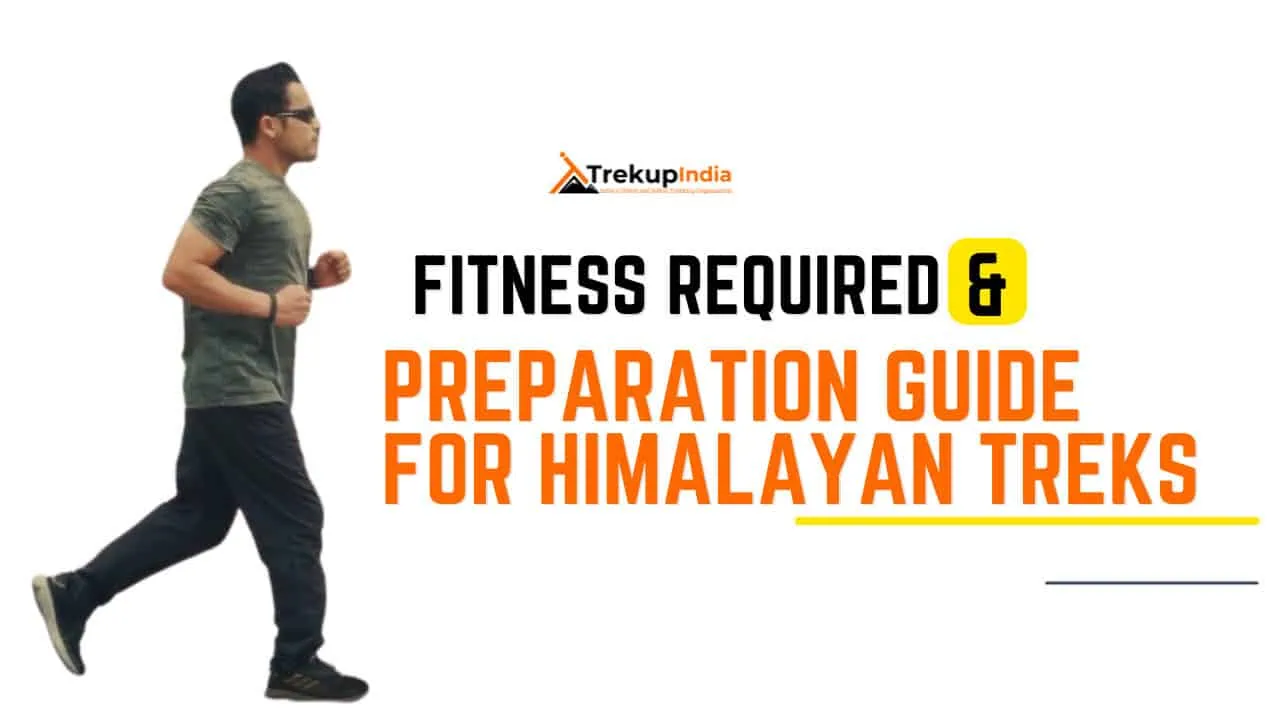
Fitness Target
Trekup India has put the Kedarkantha Trek into an easy-to-moderate-grade-level trek.
For Easy – Moderate Treks – In order to be well-prepared for your upcoming trek, it is recommended that you focus on building your endurance by aiming to cover a distance of 4.5 kilometers in less than 45 minutes. This will help you to develop the necessary stamina and strength required to successfully complete your journey.
How to Achieve This Fitness Target?
To start preparing for your trek:
- Try jogging for at least five days every week.
- If you find 5 km too difficult at first, begin with 2 km and gradually increase over 2-3 weeks.
- Once you feel more comfortable running 5 km, focus on improving your speed gradually on a daily basis.
It is important to ensure that you can consistently complete 4.5 km in under 40 minutes for at least two weeks before your planned trek. Allow yourself 6-8 weeks to prepare physically for the journey.
Strength Training exercises that benefit Trekking
Trekking is an activity that demands a good level of strength.
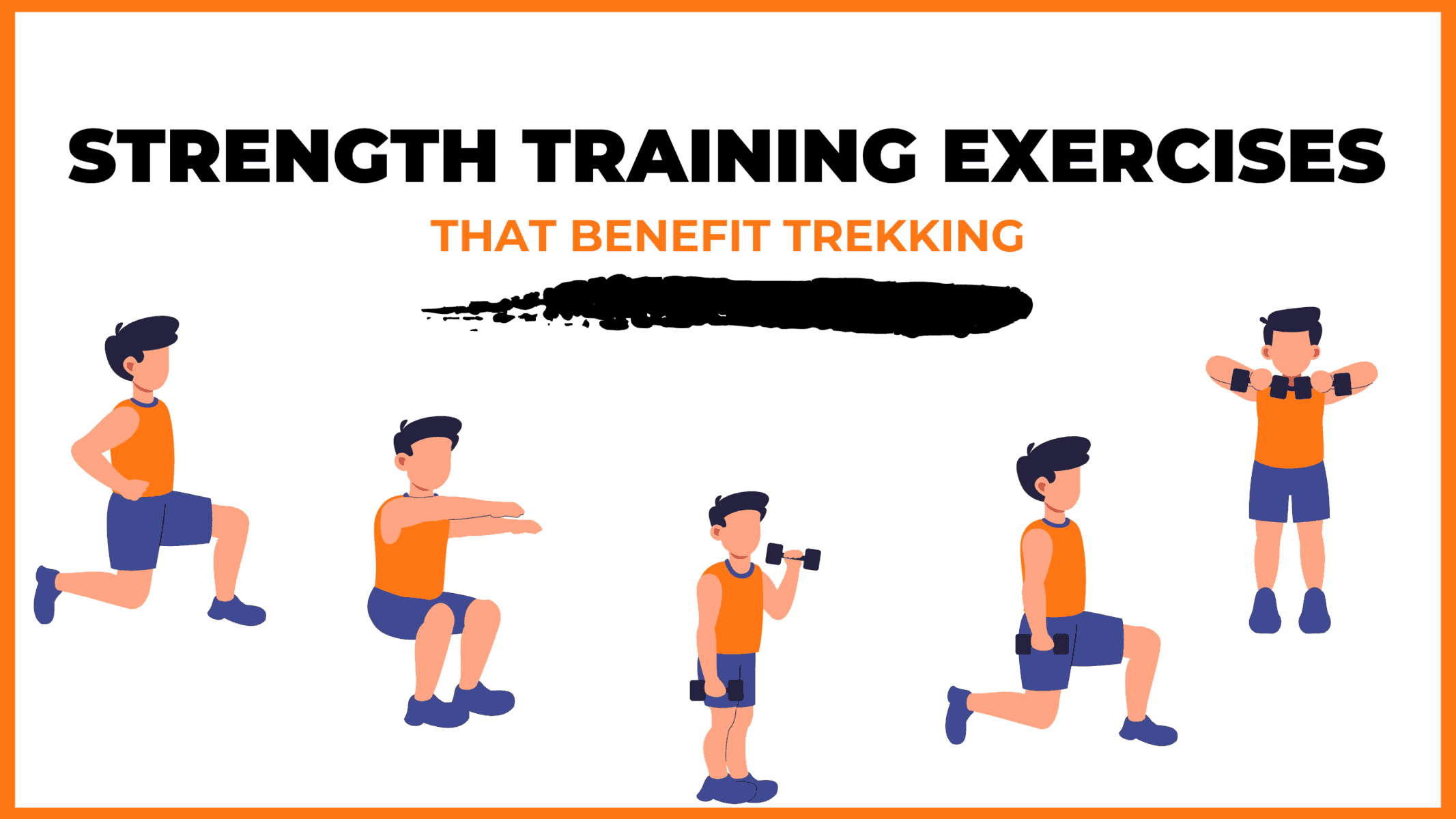
Trekking is a demanding activity that requires good cardiovascular endurance, muscular strength, and overall fitness. To help you prepare for your trek, incorporating bodyweight exercises into your training routine can be an effective way to build strength, improve stability, and enhance endurance, all of which are crucial for a successful trek. In this regard, here’s a breakdown of body weight exercises categorized by the specific body parts they target and the benefits they offer during trekking.
1. Lower Body Exercises
Lower body exercises like squats and lunges are great for building lower body strength, essential for trekking.
a. Squats
Squats are an excellent exercise for building lower body strength, essential for trekking. They target the quadriceps, hamstrings, glutes, and calves. Solid quadriceps and glutes provide power for ascending and tackling uphill climbs, while vital hamstrings aid stability during descents. This is particularly helpful in navigating uneven terrain during trekking.
How to perform Squats Exercises:
- Stand with feet shoulder-width apart, toes pointing slightly outward.
- Lower your body by bending your knees and hips, keeping your back straight.
- Lower until your thighs are parallel to the ground or as low as comfortable.
- Push through your heels to return to the starting position.
b. Lunges
Lunges target the quadriceps, hamstrings, glutes, and calves. They improve lower body strength, balance, and stability, crucial for maintaining control on rocky trails and steep slopes. Additionally, they enhance flexibility, reducing the risk of injury while trekking.
How to Perform Lunge Exercises:
- Stand with feet hip-width apart, hands on hips or sides.
- Take a step forward with one foot, lowering your body until both knees are bent at 90-degree angles.
- Push through the heel of your front foot to return to the starting position.
- Repeat on the other side, alternating legs.
2. Upper Body Exercises
Upper body exercises such as push-ups and pull-ups effectively strengthen the upper body, especially the chest and shoulders, which are essential for carrying a backpack during treks.
a. Push-Ups
Targets: Chest, shoulders, triceps, and core.
Benefits for Trekking: Push-ups are an effective exercise to strengthen the upper body, especially the chest and shoulders, essential for carrying a backpack during treks. Improved upper body strength will also help maintain posture and stability while traversing challenging terrain.
How to Perform Push-Ups Exercises:
- Start in a plank position with hands shoulder-width apart and body in a straight line from head to heels.
- Lower your body by bending your elbows until your chest nearly touches the ground.
- Push through your palms to return to the starting position.
- Keep your core engaged throughout the movement.
b. Pull-Ups/Bodyweight Rows:
Targeting the back, biceps, and shoulders can significantly benefit trekking. You can strengthen these muscle groups by performing pull-ups or bodyweight rows and improve your posture and balance while carrying a backpack. Additionally, more muscular back muscles can help reduce the risk of back strain and fatigue during long treks, making your journey safer and more comfortable.
3. Core Exercises
Core exercises like planks and Russian twists can help strengthen the core muscles, which are crucial for maintaining stability and balance while trekking on uneven terrain.
a. Planks
Targets: Abdominals, obliques, and lower back.
Benefits for Trekking: Planks are an effective exercise that helps strengthen the core muscles. These muscles are crucial for maintaining stability and balance while trekking on uneven terrain. A strong core also helps improve posture, reducing the risk of back pain and fatigue during extended hikes.
How to Perform Planks Exercises:
- Start in a plank position with elbows directly under shoulders and body in a straight line from head to heels.
- Engage your core and hold the position, avoiding sagging or arching the back.
- Keep breathing steadily and hold for the desired duration.
b. Russian Twists
Targets: Obliques, abdominals, and lower back.
Benefits for Trekking: Russian twists engage the core muscles, particularly the obliques, improving rotational stability and balance. Enhanced core strength helps prevent injuries and improves overall performance during trekking.
How to Perform Russian Twist Exercises:
- Sit on the ground with knees bent and feet flat, leaning back slightly to engage the core.
- Clasp hands together and twist the torso to one side, bringing the hands towards the ground beside the hip.
- Return to the centre, then twist to the other side.
- Continue alternating sides for the desired number of repetitions.
4. Full Body/Cardiovascular Exercises
Full-body/cardiovascular exercises like burpees and mountain climbers are excellent for improving cardiovascular endurance, strength, and agility.
a.Burpees
Burpees are an excellent full-body exercise that targets your legs, chest, arms, and core. This exercise dramatically benefits trekking enthusiasts, improving cardiovascular endurance, strength, and agility. Regularly incorporating burpees into your workout routine can enhance your overall fitness level, which can help you endure long hikes and rugged terrains with ease.
How to Perform Burpees Exercises:
- Start in a standing position.
- Squat down and place hands on the ground.
- Jump feet back into a plank position.
- Perform a push-up.
- Jump feet back to the squat position.
- Explosively jump up into the air, reaching overhead.
- Land softly and repeat the sequence.
b. Mountain Climbers
Mountain climbers target the core, shoulders, chest, and legs. This dynamic, full-body exercise can significantly improve cardiovascular endurance and agility. It is an excellent functional workout for trekking preparation as it engages both the upper and lower body muscles while strengthening the core muscles.
How to Perform Mountain Climbers Exercises:
- Start in a plank position with hands shoulder-width apart and body in a straight line from head to heels.
- Drive one knee towards the chest, then quickly switch legs, alternating in a running motion.
- Keep the core engaged and the hips stable throughout the movement.
- Continue at a moderate to fast pace for the desired duration.
Incorporating bodyweight exercises into your training routine can help you build strength and endurance and prepare your body for the physical demands of trekking. Consistency and proper form are crucial to maximizing the benefits of these exercises and ensuring a safe and enjoyable trekking experience. Engaging your core muscles, including obliques, abdominals, and lower back, with Russian twists can improve your rotational stability and balance, preventing injuries and enhancing overall performance during trekking.
When incorporating strength training exercises into your workout routine, it’s essential to maintain proper form and technique to avoid injury. Start with lighter weights and gradually increase the intensity as you progress, focusing on compound exercises targeting multiple muscle groups simultaneously. Some examples of practical strength training exercises for trekking include squats, lunges, deadlifts, and pull-ups.
Remember to give your muscles time to recover between workouts, and remember to stretch before and after your workouts to prevent injury and improve flexibility. Combining strength training with jogging and proper stretching allows you to take your fitness to the next level and confidently tackle even the most challenging treks.
Our Trekkers Reviews And Expreinces





We provide only Indian vegetarian food, and your meal will mainly consist of Indian bread, vegetables, lentils, rice, and a delicious dessert. During your trek, we will serve three meals a day, including breakfast, lunch, and dinner. You will also be served tea, snacks, and lip-smacking soup in the evening before dinner. If it is a long day of trekking, you will be given a packed snack.
After extensive research on the trekkers’ nutritional requirements, we prepare the menu. Before putting all the meals together, we also consider the altitude and the weather.
The meal we serve during the trek is perfectly balanced with calories, carbohydrates, vitamins, protein, fibre, and minerals. You need to know that all our cooks have great expertise in cooking and have undergone thorough training. So, get ready to enjoy delectable and lip-smacking dishes during your trek. You will be served with lemon tea in the tent to start your day with a refreshed feeling. Before leaving the campsite for trekking, you will be given a hot finger-licking breakfast like upma, Aallu Prantha, Besan Chilla, Poha, Daliya, Corn flakes, and Maggie, along with tea or coffee.
If your trek is longer, we also offer some fresh local fruits such as apples and healthy drinks like Frootie or Maaza. In the afternoon, you will be served a simple & healthy lunch, while at around 04:00 pm, you will be given tea and a light evening breakfast. After you reach your campsite at night, you will be served a hot and delightful dinner.
After reading this, you must have understood the food we provided on the trek; you don’t need to worry about food. Many trekkers repeatedly trek with us because of the food we provide. Thus, we will give you unforgettable experiences.

Trekking with us for the Kedarkantha Trek is entirely safe because we have a team of trek leaders qualified in Wilderness first-aid and complete information about the high-altitude glitches. During the trek, we carry a full first-aid kit that contains all the essential medicines. Before trekking with us, you must ensure that you are medically fit for the trek; for us, your medical fitness is more important than anything else.
Right from our establishment, we at Trekup India have been continuously introducing new safety practices into Indian trekking to ensure the safety of voyagers. Trekup India introduced microspikes and made emergency bottled oxygen mandatory for all treks. Our trek leaders take your daily Pulse oximeter reading. We at Trekup India introduced the radio walkie-talkie as a safety communication device.
How can we ensure that your trek is safe with us?
We have noticed that most trek-organizing organizations do not follow these systems, but with time, they are following us; several competing companies are adopting these practices and organizing great, safe treks.
We ensure complete technical safety in the mountain. Our company has a vast team of more than 100 guides and trek leaders who serve on Himalayan treks. One of the best things about our team is that all the members are trained professionally by the Nehru Institute of Mountaineering, Indian Mountaineering Foundation Delhi, and Hanifle Center Outdoor Education Mussoorie.
Explore our New Safety Protocols
To ensure a perfect Trek, we have introduced some new safety checks to ensure excellent safety for our trekkers.
Our On-trek safety checks include:
- Daily oxygen saturation, along with pulse readings
- Stretchers team appointed on every trek
- Radios
- Trained mountain staff and complete safety
- Additional oxygen cylinders
- Special medical kit for high-altitude treks
- Microspikes on all types of snow treks
- Experienced Trek leaders, as well as safety
- Technical team on all snowy slopes
For Us, Your Safety Is the Top Priority
At Trekup India, you will find a team with local knowledge and fluency in English and Hindi. This helps ensure that you have a fantastic trek. Not only this, but we also pay attention to your health and safety because this is something we cannot ignore. All the team leaders involved in trekking have already undergone several professional courses in first aid, portable altitude chamber training, CPR, environmental awareness training, and advanced wilderness emergency medicine.
We also carry a complete first aid medical kit on every trek and trip we organize. Apart from the medical kit, we take a portable altitude chamber (if needed) and medical oxygen for all high-altitude treks. Our company has significant expertise in organizing all sorts of group adventure holidays for family groups, school and college groups, and friend groups. We have many travel options that suit different fitness levels and travelling styles.
Regardless of the group size, we value each and every member of our trekking groups. Our commitment to personal attention ensures that your needs and safety are always our top priority.
Who we are?
Trekup India has been a stalwart in the Adventure Tourism industry for 30 years. Since our inception, we have been dedicated to providing top-notch treks, voyages, trekking programs, and high-altitude expeditions. Our extensive experience is a testament to our commitment to your adventure and safety.
We organize treks in Uttarakhand, Kashmir, Sikkim, and Himachal while being part of the trekking community; we feature more than 75 documented Himalayan treks. In addition to other outdoor activities, our company also organizes trips for schools, colleges, and families.
Therefore, we maintain the quality of services offered to our valuable customers.
Must Read These Information Of Kedarkantha Trek
Why You Should Do Kedarkantha Trek
Kedarkantha Trek is one of the famous winter treks that you should definitely go once, in your lifetime. Make sure to carry all your gears properly because the lovely snow-covered scenery and an adventurous summit climb can make anyone go weak in the knees. After March, the snow begins to retreat opening up the lavish green pasture beneath with colorful flowers thriving during the spring and summer seasons. Get ready to camp among the woodlands, deep in the dense forestry of the Govind Vihar National Park right in the Himalayas of Uttarakhand.
You will also trek through the thick forest covered with Himalayan Coniferous trees. If you are a beginner then this trek is the right winter trek for you. During trekking, you will experience a perfect combination of beauty as well as adventure. Not only this, but you will also trek through the dense forests that are covered with ice completely. During the trek, you will learn to camp in clearings on thick mounts of snow. Be prepared because the summit climb will get your adrenaline kicking with the thick snow until and unless you reach the summit.
During the winters, you will get the chance to experience fresh snowfall, high snow, and even extremely cold nights while trekking. Trekking on snow-covered mountains is really worthwhile. It is not only a classic winter trek but also one of the topmost & best winter treks in the entire Himalayas. The breathtaking views of nature are strictly reserved for the trekkers who make the effort. The sight is so amazing that you will forget for your entire life.
From the top, the views are marvelous and beyond your expectations. You will not only see the popular peaks such as Gangotri, Bandarpoonch, Kalanag, Yamunotri, and Swargarohini range but several other unnamed peaks. Trek has the most attractive campsites in the Himalayas such that no trekking place can ever match up the beauty of this winter snow trek. Each of the campsites present in this trek is unique and offers mesmerizing views of the landscape.
There is a charm in this world, you just need to be in the right place for experiencing it. This trek embraced with beauty which gives the photographers a perfect chance to capture some eye-catchy pictures of nature. Every frame appears just like a postcard image.
Best time to do Kedarkantha Trek
In the Indian Himalayas, the Kedarkantha trek is one of the few treks where you can trek any time of the year except July and August month because it is the rainy season of Uttarakhand. In summer, you will find mild weather here. This is the time when neighboring mountains are visible.
In Monsoon
In case, you are planning the this trek during the monsoon then you have to face difficulties. During monsoon, landslides take place and lead to road blockage. Although it is going to be a little tireless but the himalayan medows view is definitely priceless of all your efforts.
In Winter
In Winter, the trail remains covered with silver sheet. As a result, the trek becomes a little hard. During the winters, this trek turns out to be difficult and exciting at the same time. Make sure to carry your heavy woolens during the trek because the temperature drops.
How Difficult is the Kedarkantha Trek
The Kedarkantha Trek is a breathtaking adventure that offers a perfect blend of awe-inspiring natural beauty and thrilling challenges. This trek, classified as Easy-Moderate, involves a rapid ascent to 12,000 feet over three days, with steep inclines and a demanding final climb to the summit. The trail during winter may be covered in snow and ice, making it necessary to use traction aids such as microspikes to ensure safety and stability.
While the trek is enjoyable year-round, winter brings frigid temperatures, emphasizing the need for proper preparation. Physical training is not just crucial, it’s the key to conquering this high-altitude trek. Cardiovascular and strength exercises are a must, especially for the winter conditions. Starting your preparation 30-45 days before the trek is recommended to build endurance and stamina.
In addition to physical training, it’s essential to be equipped with the right gear, including appropriate clothing, insulated layers, and cold-weather accessories. Understanding the potential challenges and being well-prepared will enhance your overall experience and ensure a safe and enjoyable trek.
If you have any questions about the trek, such as gear recommendations, training tips, or general inquiries, please call +91-7060017566. I wish you a fantastic and memorable trekking experience!
Mythological Stories About Kedarkantha Trek
The folklore surrounding Lord Shiva’s connection to Kedarkantha is diverse and intriguing. One prevalent legend suggests that Lord Shiva initially chose the Kedarkantha peak for his meditation but was compelled to depart due to disturbances from the nearby villages. Subsequently, he relocated to Kedarnath. At the summit of Kedarkantha, a quaint shrine is dedicated to Lord Shiva, which serves as a testament to this narrative. Moreover, the awe-inspiring panoramic view from the peak may have played a significant role in Shiva’s initial selection of this location.
The summit of Kedarkantha offers an expansive and breathtaking panoramic view, encompassing numerous prominent peaks such as Nanda Ghunti, the Yamunotri range, the Gangotri range, Draupadi ka Danda, and many others. This makes it a truly captivating and spiritually significant site.
Frequently Asked Questions About Kedarkantha Trek
Where is Kedarkantha Trek Located?
It is situated in the quaint Himalayan village of Sankari, nestled in the Uttarkashi district of Uttarakhand, India.
How to reach the main pickup location of Kedarkantha Trek i.e. Dehradun?
Accessibility:
Nearest Airport: Jolly Grant Airport, Dehradun
Nearest Railway Station: Dehradun Railway Station
Nearest Bus Stand: ISBT (Inter-State Bus Terminal), Dehradun
How to reach start point of the trek i.e. Sankari?
Transportation from Dehradun to Sankari:
Trekup India usually offers reliable transportation services between Dehradun and Sankari, both for arrival and return. However, if you prefer to travel by public transport, Uttarakhand Roadways operates 2–3 buses daily from Dehradun to Sankari. These buses typically depart in the early morning hours, between 05:30 AM and 07:30 AM. It is strongly recommended to check and confirm the latest bus timings with official sources prior to your journey.
How many days is Kedarkantha Trek?
Duration:
The recommended duration for the trek is 5 nights and 6 days, allowing for a comfortable pace and proper acclimatization throughout the journey.
How difficult is Kedarkantha Trek?
Trek Difficulty & Preparation:
This is an easy to moderate trek, making it accessible to most beginners with a reasonable level of fitness. With the right preparation, anyone can attempt and successfully reach the summit. However, it’s important to note that the trek involves a rapid gain in altitude, so maintaining good physical fitness is essential. It is strongly recommended to begin a basic fitness routine, including cardio and strength training, at least a few weeks before the trek.
How Long is Kedarkantha Trek?
Trek Distance & Scenic Highlights:
The total trek covers approximately 20–22 kilometers, offering an incredible Himalayan trail filled with mesmerizing landscapes, breathtaking sunrises, and stunning 360-degree views of the surrounding Himalayan peaks. It’s a visual treat for nature lovers and photography enthusiasts alike.
Is Kedarkantha good for beginners?
Suitability for Beginners:
Yes, the Kedarkantha Trek is considered an easy to moderate trek, making it an excellent choice for beginners. However, it’s important to maintain good physical fitness. Preparing with a daily walk or jog of 4–5 kilometers along with basic exercises will help you complete the trek comfortably and enjoyably.
What is Best time for do Kedarkantha Trek?
Best Time to Visit:
The best time to undertake the Kedarkantha Trek is from October to April. However, if you’re a snow lover, the ideal window is from mid-November to February—with December offering abundant snowfall, creating a magical winter wonderland along the trail.
What Kedarkantha Trek is Famous for?
Unique Highlights of the Kedarkantha Trek:
The Kedarkantha Trek stands out for several reasons, making it a favorite among trekkers of all levels. Some of its key highlights include:
One of the best and safest snow treks in India, ideal for beginners and experienced trekkers alike
Stunning 360-degree views of snow-capped Himalayan peaks from the summit
A rare night trekking experience, adding adventure and uniqueness to the journey
A breathtaking sunrise from the summit that’s truly unforgettable
A place of spiritual significance—locals believe Lord Shiva once meditated here, and the original Kedarnath temple was initially meant to be built at this site
The charming Himalayan village of Sankari, known for preserving its traditional Garhwali culture and hospitality
Which are the Himalayan peaks visible from Kedarkantha Summit?
Panoramic Views from the Summit:
One of the most rewarding aspects of the Kedarkantha summit is its 360-degree panoramic view of the majestic Himalayas. On a clear day, trekkers are treated to stunning vistas of several prominent peaks and ranges, including:
Swargarohini Peak
Kala Nag (Black Peak)
Bandarpunch Mountains
Yamunotri Ranges
Draupadi ka Danda
Nanda Ghunti
Rupin Valley
Har Ki Dun Valley
…and many more snow-clad giants stretching across the horizon.
Where do we keep our extra luggage, when on trek?
Luggage Storage Facility:
Trekup India offers a luggage storage room in Sankari, allowing trekkers to leave behind any extra luggage before embarking on the trek. However, it is important to note that valuable items and electronic gadgets should not be stored, as safety and security cannot be guaranteed for such belongings.
How Much Does Kedarkantha Trek Cost?
Choosing the Right Operator:
To be completely honest, there are numerous operators offering the Kedarkantha trek, and as a result, prices can vary significantly, ranging from ₹4,000 to ₹10,000 per person. It’s important to remember that the price you choose often reflects the quality of services provided. If you’re looking for reliable and trusted services, a price range of ₹6,000–₹6,500 per person is a reasonable expectation, which should also include transportation from Dehradun to Dehradun.
When selecting your travel agent, be sure to choose wisely and avoid falling victim to online frauds. Always prioritize trustworthy, well-reviewed operators to ensure a safe and enjoyable experience.
How to choose right Trek operator for Kedarkantha Trek?
Avoiding Online Frauds & Ensuring Safety:
We strongly advise against falling prey to online frauds. To ensure a safe and reliable trekking experience, always verify that the trek operator is at least registered with the State Tourism Board. Additionally, you can inquire whether the operator holds affiliations with reputable organizations such as:
Adventure Tour Operators Association of India (ATOAI)
Indian Mountaineering Foundation (IMF)
Ministry of Tourism, Government of India (MOI)
These affiliations are indicators of professionalism, expertise, and adherence to safety standards, providing you with greater peace of mind during your trek.
How much luggage should be we carry for Kedarkantha Trek?
Packing Tips:
It’s essential to carry only the items you truly need to avoid overburdening yourself. A 60-70 liter backpack should be more than sufficient for the trek. Ideally, your backpack should not exceed 9-10 kg in weight, ensuring a comfortable and manageable journey.
What is luggage off loading charges on Kedarkantha Trek?
Offloading Facility:
Trekup India offers offloading services for your convenience, allowing you to send some of your luggage ahead to the next campsite. The cost for this service is approximately ₹450–₹500 per bag per day, with a weight limit of 9 kg per bag. You can easily book this service upon arrival in Sankari, after meeting our Base Camp Manager or Trek Leaders.
Is there Extra luggage Store room available in Kedarkantha Trek?
Luggage Storage Facility:
Trekup India provides luggage storage facilities at their accommodation in Sankari. However, please ensure that valuable items and electronic gadgets are not left in your stored luggage. Additionally, make sure your luggage is secured with a proper locking system for added safety.
Is there any network in Kedarkantha Trek? Which sim Card works better?
Network Connectivity:
Currently, the Jio network works quite well in Sankari. However, please note that no network will be available once you move beyond Sankari, so it’s a good idea to inform your loved ones in advance and prepare for limited connectivity during the trek.
What should we pack for Kedarkantha Trek?
Packing List:
For a complete list of essential items to pack, please follow this link: [Things to Pack].
How should we prepare for Kedarkantha Trek?
Pre-Trek Fitness Tips:
Begin a daily walk or run of 4-5 kilometers, along with regular exercise routines to build endurance. Make breathing exercises a part of your routine to improve oxygen intake at higher altitudes. Additionally, it’s crucial to quit smoking and alcohol immediately to ensure optimal health and fitness for the trek.
What temperature we can expect on Kedarkantha Trek?
Weather Conditions:
December and January are the coldest months, with daytime temperatures ranging from 10°C to 15°C. At night, temperatures can drop to as low as -4°C, so be prepared for chilly conditions, especially after sunset.
Is Kedarnath and Kedarkantha Same trek?
Kedarnath vs. Kedarkantha:
Kedarnath and Kedarkantha are two completely different destinations, located in separate areas. Kedarnath is part of a Yatra (pilgrimage) trip and is situated in the Rudraprayag district, while Kedarkantha is a trekking destination located in the Uttarkashi district. Both fall within the state of Uttarakhand, but their experiences and purposes are distinct—one is a spiritual journey, and the other is an adventurous trek.

